#stay tuned for more Big Brother Sonic
Explore tagged Tumblr posts
Text

I recently got an ask about Sonic and Clementine's relationship, and I will draw more stuff for it, but I think this needs to be its own thing because I actually rly like how this turned out aosjsksbd
#stay tuned for more Big Brother Sonic#and Anxious Dad Mario#and Slightly Anxious Mom Peach#possibly#mario#super mario#super mario bros#mareach#mario x peach#princess peach#smb#mario bros#peach x mario#sonic#sonic the hedgehog#sth#sonic fanart#fanchild#fankid#nintendo
898 notes
·
View notes
Text
CASSETTES REFERENCES [PT1]
I have other bots I’m working on but of course I did my favorite ones first. Bee and his siblings will be posted soon so stay tuned if you’re interested!

Meet Rumble!
The most well known of the cassettes, and he enjoys his reputation. This street punk bot is known for his smarts on navigating cities and his wits. While Ravage was the one who taught him to track, that fact somehow disappears when Rumble brags on his skills. Equipped with his piledrivers, ray guns and sharp denta. This con is not one you want to come across in a dark alley.
Able to drag bots with just his bare teeth five times his size. Along with his brother, Rumble works as search and rescue for fallen cons. Putting his strength to good use and taking bots to safe areas during warfare. He also works as a good guard in numerous situations. Though his biggest weakness is his big mouth and tendency to get distracted. Even with his gruff demeanor, this bot has a shielded spark of gold for those he cares for. A positive attitude up to his siblings. This cassette bot’s loyalty has no bounds and he’d follow Soundwave to the ends of the galaxy.

Meet Frenzy!
The bot in his brother’s shadow, Frenzy is a con that’s fueled by chaos and nothing more. He’s less following of orders out of loyalty, and more for pure insanity and warfare. Due to his insane tendencies, Soundwave keeps him docked much more than his twin. But when he’s released no bot is in for a fun time. While Frenzy shares piledrivers and a sonic scream ability with his brother. His main reason for being ejected is a unique skill his siblings don’t share. Frenzy can track mechanical viruses in numerous machinery. Including other cons. A bot has the start of Cosmic Rust and is unaware? Frenzy can smell it before it’s visible.
Usually working in cassette mode to take viruses head on. Which may be a reason why he enjoys his job so much. Frenzy will take any opportunity to fight, and lash out at anything he sees fit. Holding a temper and a pessimistic attitude, rather than hyper serotonin like his twin. Though don’t let his aggressive attitude fool you. He enjoys a game of fetch as much as his brother. Though he’ll have a rude laugh if he’s dragging you to safety out of a shootout.

Meet Enemy!
The most unique, unnerving and mysterious of the cassettes. Enemy is the older brother of Rumble and Frenzy. A bot who hates everyone and feeds off said hatred. Enemy is a pure solo individual, hating any situation where he has to team up with his fellow cons. Due to his highly introverted nature, not much is known on this cassette. A search and rescue con back in his younger days, Enemy ended his career in an intense accident. Taking the bomb for a con and left to die from the con he saved. Only taken in by Soundwave, who never gave up on him.
Due to that experience, Enemy is loyal to no one. He trusts no one and enjoys to be around no one. The bot’s spark refused to dissipate, even if his body gave in to his fate. Similar to a zombie, Enemy wanders as a phantom when he’s not in Soundwave’s dock. Vocoder glitched with static when he attempts to speak, most bots have only heard him growl in the past couple centuries. Polluted with confusion on who and what he is, Soundwave keeps him in the dock for years at a time. Which Enemy also prefers. Even with his lack of toleration for his siblings, he’d refuse to let his fate follow suite with Rumble and Frenzy.
Welp that’s the cassettes! More content coming soon!
If you’re interested in my content, PLEASE REBLOG AND FOLLOW! 💕
#transformers#transformers fanart#rumble#frenzy#enemy#soundwave#transformers g1#transformers rumble#transformers frenzy#transformers soundwave#tf rumble#tf frenzy#tf enemy#tf soundwave#transformers headcanons#headcanon#headcanon design#reference sheet#ref sheet
36 notes
·
View notes
Text
AMY’S CHARACTER BIO: METAL BREAKERS AU
NAME: Amy Rose
AGE: 28
SPECIES: Hedgehog
HEIGHT: 3’4”
WEIGHT: 85 lbs
OCCUPATION:
Head of Humanitarian resources.
PHYSICAL STATUS:
Amy is physically fit; although her role rarely requires combat, she prefers to stay prepared. She makes routine visits to the training hall to keep her body in top condition for any unexpected encounters with bandits or Metal Empire patrols.
MENTAL STATUS:
Amy is mentally stable, faring fat better than her found family and acting as the voice of reason when Tails and Knuckles falter. Though the wasteland and her role have made her more stern, her kindness, compassion, and drive to help others remain unchanged.
COMBAT EFFICIENCY:
Amy is a ruthless and highly skilled fighter, wielding her Metal Breaker Hammer with both strength and precision. The hammer is a custom made weapon designed by Tails, forged from a chaos energy infused alloy that makes it nearly indestructible. The face of the hammer is tuned to a specific energy frequency engineered to counter the unique properties of Metal Spawn armor, allowing it to tear through enemies that are otherwise impervious to conventional weapons. In addition to her natural combat prowess, Amy received training in the martial traditions of the Echidna warriors, under Knuckles’ guidance (though to a lesser extent than Tails). This has given her a solid foundation in disciplined combat techniques, complementing her already formidable strength.
RELATIONSHIPS:
Amy is the most social member of the inner circle, so she naturally has the most connections. As head of humanitarian resources, she maintains ties with leaders of settlements across the wasteland. Her closest relationships include Big, Rouge, Kit, Surge, and Cream. Her long standing bond with Tails and Knuckles has grown into a familial connection, with Tails as her troubled younger brother and Knuckles as her stoic, protective older brother.
BACKGROUND:
Amy was once a young girl searching for her place in the world, trying to understand where she belonged and who she was meant to be with. She turned to tarot cards for guidance, which led her to Little Planet in search of her destined knight in shining armor. There, she met Sonic the Hedgehog, who she believed was the one the cards had spoken of. She was instantly captivated by his bravery and skill as he fought through the robots that had overtaken the peaceful planetoid. Enthralled, she followed his journey, cheering him on and giving him a few surprise hugs along the way.
However, her adventure took a dark turn when she was suddenly kidnapped by Metal Sonic and taken to Robotnik’s factory. There, she was used as bait in a trap meant to lure Sonic into a final showdown with Metal Sonic, a battle Robotnik and Metal believed would be Sonic’s last. But Sonic triumphed, defeating Metal Sonic and rescuing Amy, who greeted her hero with another unexpected hug. He then stormed the factory, destroyed the Egg Spinner, and foiled Robotnik’s plan to seize control of Little Planet. As the factory collapsed, Sonic grabbed Amy and rushed her safely back to earth, vanishing before she had a chance to properly thank him.
Amy didn’t return home after that encounter. Still convinced Sonic was her destined love, she continued to follow him, eventually arriving at Tails’ workshop just as Sonic had come to meet the young fox. This marked her first meeting with Tails. While she could tell he found her infatuation with Sonic a bit silly, he treated her with the same kindness she showed him, and they quickly became friends.
Her time with Sonic and Tails here was brief however, as Tails' scanner suddenly detected a distant energy signal. As the two prepared for an unexpected new adventure, Amy offered to help and asked to join them aboard the Tornado. But Sonic gently persuaded her to stay behind.
Amy's breath caught in her throat. Her legs felt like they would give out from under her as she stumbled forward, eyes locked on Tails' limp form. Questions tumbled through her mind, but none of them reached her lips. She was too stunned, too afraid to even ask where Sonic was. Knuckles approached her, his gaze heavy with unspoken sorrow as he laid Tails gently on the ground. He explained that Tails and Sonic had been attacked during their mission, blindsided by something neither of them had anticipated.
Amy stayed at Tails' workshop while Sonic and Tails were off on their adventure, determined to take care of the place until they returned. She spent her days cleaning, organizing Tails' workbenches, and keeping everything in order, wanting to be there to greet Sonic with a smile the moment he came back. After three long days, the sound of the Tornado's engine signaled their return, and she rushed outside, eager to see them. But her excitement quickly turned to shock as a red echidna stepped out of the plane instead, carrying a bloodied and barely conscious Tails in his arms. His right arm was gone, hastily bandaged with vines and leaves, leaving Amy horrified and confused about what had happened, and why Sonic wasn't with them.
Knuckles explained that Tails and Sonic had been attacked, and he barely managed to catch Tails before he bled out or hit the ground. He wasn’t sure what had happened to Sonic, but they assumed he was either dead or captured. Amy's heart sank as she tried to process the news, unable to accept that Sonic was gone. He was always so strong, so unstoppable. But Knuckles’ solemn expression left no room for doubt. Whether dead or captured, Sonic wasn’t with them. Amy wanted to collapse, overcome with grief, but the sight of Tails, injured and barely holding on, kept her grounded leaving her no time to mourn the possible loss of her true love.
Despite her sorrow, Amy stood strong for Tails, who was now unable to fight for himself. She stayed by his side, helping him recover, and once he could stand again, she joined him and Knuckles on a harrowing journey through a world collapsing under the Metal Emperor’s iron grip. They fled from city to city, dodging destruction, aiding civilians, and watching society unravel with each passing day.
Years passed, and Amy’s role shifted from a hopeful girl chasing destiny to a leader carrying the weight of countless lives. Alongside Tails and Knuckles, she helped found the Metal Breakers, a resistance force born from the ashes of what once was. The group became the last spark of rebellion in a darkening world. While Tails led as their chief strategist and scientific mind, with his lab assistant Chris at his side, Amy took charge of humanitarian resources, ensuring the survival and well being of every soul who dared to stand against the Metal Empire, as well as the innocent lives of those roughing it through life in the wastelands.
Through it all, Amy never forgot Sonic. Her love for him remained, buried beneath duty and resilience. But it was her found family, Tails, Knuckles, and the people who now depended on her, that gave her purpose, strength, and a reason to keep fighting.
20 notes
·
View notes
Text

Finally gonna give y’all a brief synopsis of these two, how they met and their relationship, tune in below the cut for that !
How they met:
This pair met a few months after Scourges break out of prison, after his gang ditch him in Mobius to let the heroes there deal with him, and Sonic finds him after a few days of his green double being on his own. The two speedsters fight, it of course being sparked by the ex king, before Sonic gets the upper hand and gives Scourge a familiar offer, to change his ways and he can stay here on Mobius. Scourge nearly slapped his hand away before realizing there’s not much he can’t do, he couldn’t return to Moebius, he had no gang, no crown, his quills were still out of shape from those awful cuts in the No Zone, and he’s noticed that his stamina has been lacking some since being dumped on Mobius… He had nothing. So he took the hero’s hand, but his intentions weren’t pure, he was planning to turn this place upside down.
This plan never game to fruition though as Sonic placed Scourge with someone who would monitor him, make sure he didn’t cause people too much trouble, kept him in line. Knuckles would never do it, especially after the green hedgehog gave himself a makeover with the master emerald. Tails could be a good candidate, but Sonic didn’t want to put that kind of burden on his little brother, and he also didn’t want Scourge living with them, as selfish as it sounded. There’s sweet Amy, she always tried to see the good in everyone, she could probably even see it in someone like Scourge! Though Sonic knew she was already spreading herself thin with her new bakery, he didn’t want to add anything else to her plate… So who else…?
Then it came to the blue blur when he saw a red leaf fluttering down, catching it in his hand with a smile. “Say, Scourge, whaddya think about meeting a good friend of mine?”
This leads to Scarlet and Scourge meeting, Sonic dragging the other hedgehog out into a cottage deep in the woods, asking the owner if she’d be willing to let Scourge stay with her until further notice. Scarlet had heard of Scourge but never had the “pleasure” to meet him, she knew what kind of things he’s done and what to expect from him, but she allows him to stay with her after listening to what Sonic has to say and even mentions how she could be a good influence on him. That just made Scourge roll his eyes. Though he stays with Scarlet but doesn’t get a chance to cause any chaos as she watches him closely and hardly lets him out of her sight at first. Clearly she took her job very seriously, much to Scourges dismay. She also didn’t care for his snide remarks and his attitude.
The first few weeks he’s on the couch while she clears out a spare room that had been used for storage, which scourge was genuinely surprised that she let him stay in put acted like it wasn’t a big deal. Then Scarlet starts taking him with on her patrols in the forest, clearing out any of Eggmans robots that wander too far in, he got to see how effortlessly she took them out only to continue their conversation a moment after. She would instead smile or even laugh at some of his comments instead of shooting him a brief look of disappointment. Scarlet also showed Scourge some of the beautiful sights that were hidden in the forest, ones that she didn’t like to share with others, that she liked to keep them to herself… She gave him chances to stab her in the back, things to hurt her with, yet he didn’t think he wanted to do that. “It would be a waste of time” is what he told himself, but really perhaps a fondness for the tiger had started to grow. Little did he know that Scarlet was starting to reciprocate that fondness.
More about their relationship:
I joke and say that Scarlet and Scourge are basically “feral guy and his keeper” which while a joke is kinda true, people refer to Scarlet as his keeper even well after they get into a relationship. Scarlet reels Scourge in whenever he goes too far and Scourge helps Scarlet let loose more, this leads to the two having an unexpectedly strong bond, especially as Scourge sees how Scarlet carries herself with confidence and never lets herself get intimidated by anything in her way yet still manages to remain kind and compassionate, including towards him. Perhaps there’s a small part of him that wishes he could be even a fraction of what she was, of who so many people of this dimension were like, but no. He’d never be some goodie two shoes, but he supposed Scarlet wasn’t quite like that… She wasn’t scared to be ruthless if it meant protecting what she cares for, it’s a tad admirable. Scourge would never admit it though.
Meanwhile Scarlet sees how unapologetically himself Scourge is, how he carved out his own identity and separate himself from other Sonics, though she believes there could have been other ways to go about that she never tells him what he should do or who he should be. If he acted more like Sonic then he would just be another Sonic rather than Scourge, and she wouldn’t ask him to change himself. She will try to gently encourage him into making better choices, be more patient with others, but she always lets the decision be his and his alone, otherwise it wouldn’t mean as much. Scourge helps Scarlet express herself more openly, while before the most people could get from her were short giggles, now she occasionally lets out full laughs that leave her in tears, laughs that seem most frequent with him as company.
What started as a situation arranged to keep Scourge out of trouble lead to something that ended up benefiting both parties so much that when Scourge was offered to stay somewhere else, Scarlet was nearly tripping over excuses for why he should stay and so he did. He knew that she would probably be lonely without him, it would definitely be dull that’s for sure!! Who would loudly and very badly sing with her that with anyone else both would be too embarrassed to, or sit on the counter and be in her way while she cooks, or even just go for walks with her to a place only the two of them know the way to… And well who else can use the wind to give him a boost and make him go even faster than he already can, and who else is there that he’d want to share that thrill with? No one. There wasn’t a single soul on Moebius or Mobius or anywhere in the multiverse he’d rather spend that time with than this girl who fully accepts him yet still makes him want to be better.
Misc:
• scarlet is taller than scourge by a few inches (not sure what her exact height is yet)
• scarlet's adopted brother, borealis, used to play guitar and left it at scarlet's house. he doesn't play it anymore and let her keep it, doesn't care what she does with it, so when scourge showed interest in it she lets him play it
• they love watching bad movies together so they can trash talk it the whole time, scourge thinks it's funny to see her more critical and even downright brutal side
• he also enjoys seeing her lose that calm composure and express her feelings more openly, especially annoyance and anger... he probably thinks it's attractive when she deservedly snaps on someone cause he's a freak like that, but it's okay cause she matches it.
#sonic the hedgehog#sonic#sth#scourge the hedgehog#sth oc#sonic oc#sonic the hedgehog oc#oc x canon#sonic oc x canon#scarlet the tiger#scarlet x scourge content lets gooooo#lees art#lees thoughts#sonic fan character#sonic fandom
13 notes
·
View notes
Text
small thing on grief ft. silver sonic & mecha because i missed them <3
-
"What are you doing."
"Travelling."
"Why?"
"Grief, I think."
A gentle morning wind slipped between the two machines as they stood by the railroad. Mecha gingerly nodded her head, armour outlined amber against a soft sunrise. Silver gave a weak smile and looked back out to the tracks, sprawling far into the distance across wastelands where their warehouse sat like an old landmark.
This was home now, as it had been for a couple of months.
"Why." Mecha quieried.
Silver frowned subtly. "Why not?"
"I would hypothesize that you are, in some manner, attempting to place physical distance between yourself and your home." Mecha offered simply.
"Not everything's gotta be psychoanalyzed, M. Sometimes things just… are." Silver dismissed her, purposely looking away - again, creating distance.
"I suppose so. However, I would like to understand your pain. You are hurting, and I see that." Mecha ventured gently, moving to stand closer to her brother. Closing that distance.
"I… feel like… there's nowhere I wanna go, but I can't stay."
"Stay where."
"With myself."
Mecha watched with interest as Silver's arm moved, crossing over his other, and his hand rubbed against his armour - stimulating his pressure sensors, no doubt for comfort. His fingertips clicked quietly as the joints in his hand moved and flexed, seeking something soothing.
"And yet, you seek reassurance from yourself." Mecha noted, still gentle. She reached to his side and took Silver's wandering hand in her own. "Speak with me. You need not carry this alone."
Silver sighed through his vents and leaned into his sibling, letting the weight of his frame sink into Mecha's strong form. "Where he used to be, there's this… hole. I feel like I'm constantly walking around it but I still fall into it. There's a brother-shaped hole in this universe."
Mecha nodded, listening carefully, tuning her auditory sensors into her brother's words like they were scripture. Her hand closed just a fraction tighter around Silver's, holding it with care that only a sibling could provide.
"Indeed, there is a great loss that we are suffering. But this morning, you have walked into the light, the cool of the air, and you continue to love him, and you will continue to love him tomorrow. Loss does not mean absence of love. It does not mean that you must stop doing what brings you joy. You are permitted to return to yourself, for doing so is not an abandonment of our love for our brother."
Silver fell quiet, listening too, and nodding slowly. His optics fell to the ground, the small plants, the tiny wild creatures scuttling about in the morning glow. They knew not of his suffering, his heartache, blissfully unaware in their own worlds which - he realized only then - were just as large, if not larger, than his own. A small part of him wanted to hate those little animals for their ignorance. Part of him then figured that, somehow, he just wanted everything to know how physical his missing was.
Why did everything else in the world step around this hole so easily? It felt like a mockery, even if the robot didn't want to become resentful.
Mecha continued in order to bring Silver back, rubbing her thumb over the back of his hand, "you may wish for a place that is big enough for this grief, however, all you will encounter is more grief when you arrive there."
"You talk so… feelingly sometimes." Silver murmured with a half-smile. He braved a look up to Mecha, only to find that warm amber visor looking down at him with undeniable care. "For a robot who says they have no empathy. How do I know you're not just saying what you think I want to hear right now to make me shut up?"
Mecha shrugged a shoulder. "Perhaps I am. Perhaps, more importantly, I speak because you are my brother, and your suffering is of great consequence to me, as is the loss of our sibling. Do not doubt that I too miss him, and do not accuse me of speaking with intent to silence you. That brings me... sadness."
"Sorry, M. I didn't mean that. Forgive me."
In the distance, the familiar roll of a freight train rattled the earth under their soles. The sound had become just a part of the routine for the robots in their new home as heavy loads made their long travel to distant cities. They were but a speck on a gas station map out there, and it brought some comfort to be so off the grid.
Silver expected Mecha to draw or distract him away from the tracks with the incoming arrival, but Mecha surprised him.
"Come. Let us travel. I have a destination in mind." Mecha instead offered, gently pulling on Silver's hand towards the spot on the horizon.
Something as small as this managed to pull a smile onto Silver's face, and he seemed to light up just a little. "Where are we going?"
"To a paint manufacturer," Mecha explained, looking back to Silver with a slight tilt of her head, "because I noticed your new habit."
Silver tilted his head, curious but a little defensive. "What habit?"
Mecha reached out and placed her palm square on Silver's forehead. "The black paint at home washes off of your armour too easily. Let us invest in something of higher quality, something that shall remain no matter the water pressure."
(So that you can return to yourself, and him, at the same time.)
Silver's face would have flushed if it could have - knowing that Mecha had seen him try to paint the arrows that Neo had - so he diverted the topic to something more consequential. "We could just fly there."
"And yet, you did not."
"You didn't remind me!" Silver blurted out, apparently forgetting all common sense for a second. "I- that was dumb. Sorry."
A lapse in logic that only heartache could account for. Mecha saw it for what it was, and did not poke fun at him.
"You may approach your grief however you must. However, when I see you step into that hole that you spoke of… it is my duty to pull you out."
"Then pull me out."
And when the train arrived, Mecha took the first leap up onto the top, pulling Silver along with her. Silver scrambled for purchase for just a moment before Mecha ushered him up with her, taking care to not scrape his paint. The heavy vehicle steadily rocked with a maternal rhythm, anchored to centuries-old rails, and the two machines took comfort in the way they leaned into each others' forms to keep their footing.
And when the train arrived, it rolled over the little holes in the earth, the tiny ants took pause, and the grass blades leaned back against the tide of the passing wind, and for a brief moment in time, those ankle-high worlds bore witness to the brother-shaped hole in the universe.
1 note
·
View note
Photo
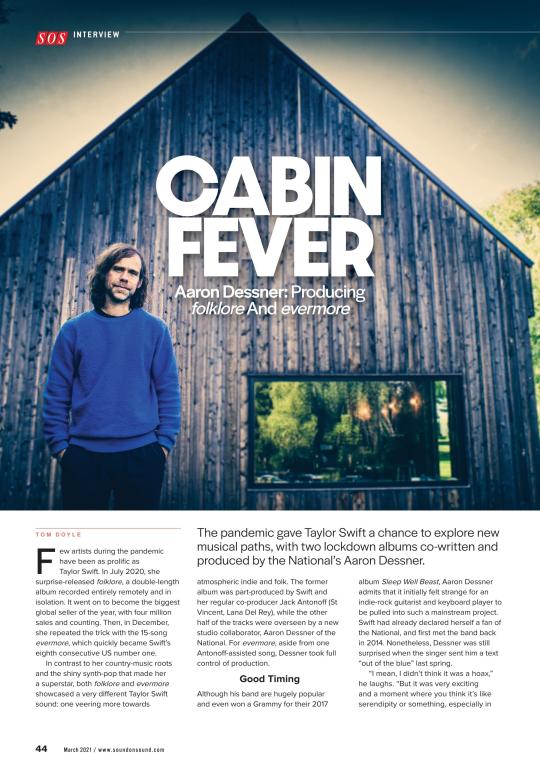
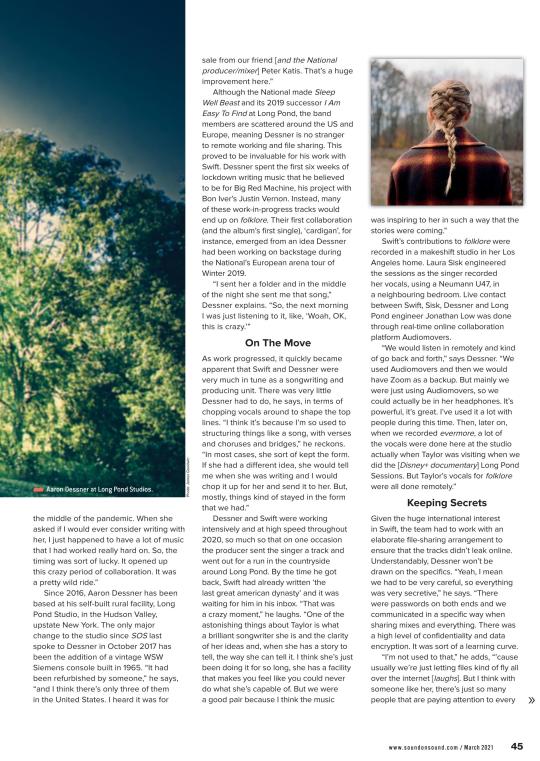
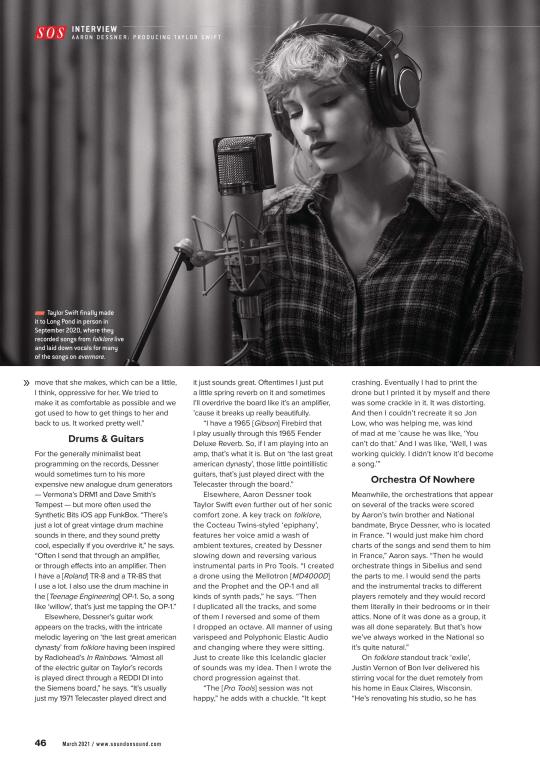
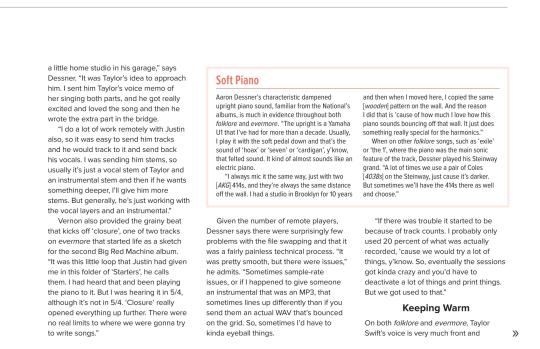



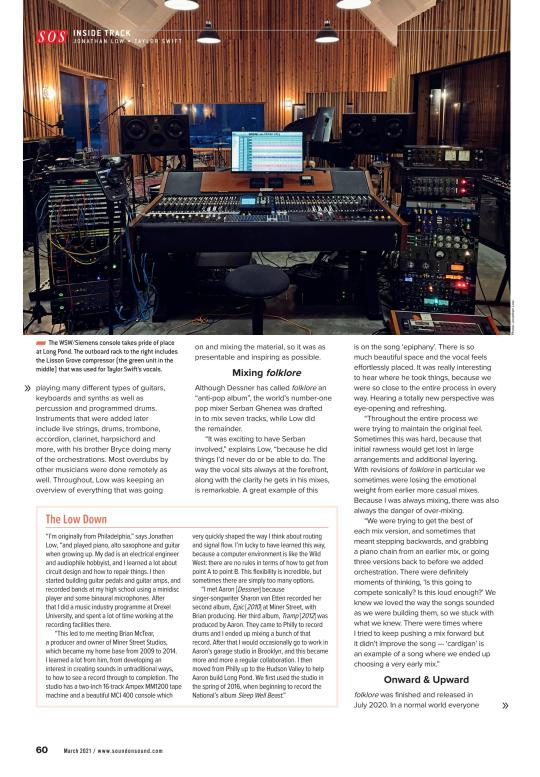


CABIN FEVER - Aaron Dessner: Producing folklore and evermore
Sound On Sound Magazine // March 2021 issue // By Tom Doyle
The pandemic gave Taylor Swift a chance to explore new musical paths, with two lockdown albums co-written and produced by the National's Aaron Dessner.
Few artists during the pandemic have been as prolific as Taylor Swift. In July 2020, she surprise-released folklore, a double-length album recorded entirely remotely and in isolation. It went on to become the biggest global seller of the year, with four million sales and counting. Then, in December, she repeated the trick with the 15-song evermore, which quickly became Swift's eighth consecutive US number one.
In contrast to her country-music roots and the shiny synth-pop that made her a superstar, both folklore and evermore showcased a very different Taylor Swift sound: one veering more towards atmospheric indie and folk. The former album was part-produced by Swift and her regular co-producer Jack Antonoff (St Vincent, Lana Del Rey), while the other half of the tracks were overseen by a new studio collaborator, Aaron Dessner of the National. For evermore, aside from one Antonoff-assisted song, Dessner took full control of production.
Good Timing
Although his band are hugely popular and even won a Grammy for their 2017 album Sleep Well Beast, Aaron Dessner admits that it initially felt strange for an indie-rock guitarist and keyboard player to be pulled into such a mainstream project. Swift had already declared herself a fan of the National, and first met the band back in 2014. Nonetheless, Dessner was still surprised when the singer sent him a text "out of the blue" last spring. "I mean, I didn't think it was a hoax," he laughs. "But it was very exciting and a moment where you think it's like serendipity or something, especially in the middle of the pandemic. When she asked if I would ever consider writing with her, I just happened to have a lot of music that I had worked really hard on. So, the timing was sort of lucky. It opened up this crazy period of collaboration. It was a pretty wild ride."
Since 2016, Aaron Dessner has been based at his self-built rural facility, Long Pond Studio, in the Hudson Valley, upstate New York. The only major change to the studio since SOS last spoke to Dessner in October 2017 has been the addition of a vintage WSW Siemens console built in 1965. "It had been refurbished by someone," he says, "and I think there's only three of them in the United States. I heard it was for sale from our friend [and the National producer/mixer] Peter Katis. That's a huge improvement here."
Although the National made Sleep Well Beast and its 2019 successor I Am Easy To Find at Long Pond, the band members are scattered around the US and Europe, meaning Dessner is no stranger to remote working and file sharing. This proved to be invaluable for his work with Swift. Dessner spent the first six weeks of lockdown writing music that he believed to be for Big Red Machine, his project with Bon Iver's Justin Vernon. Instead, many of these work-in-progress tracks would end up on folklore. Their first collaboration (and the album's first single), 'cardigan', for instance, emerged from an idea Dessner had been working on backstage during the National's European arena tour of Winter 2019.
"I sent her a folder and in the middle of the night she sent me that song," Dessner explains. "So, the next morning I was just listening to it, like, `Woah, OK, this is crazy."
On The Move
As work progressed, it quickly became apparent that Swift and Dessner were very much in tune as a songwriting and producing unit. There was very little Dessner had to do, he says, in terms of chopping vocals around to shape the top lines. "I think it's because I'm so used to structuring things like a song, with verses and choruses and bridges," he reckons. "In most cases, she sort of kept the form. If she had a different idea, she would tell me when she was writing and I would chop it up for her and send it to her. But, mostly, things kind of stayed in the form that we had."
Dessner and Swift were working intensively and at high speed throughout 2020, so much so that on one occasion the producer sent the singer a track and went out for a run in the countryside around Long Pond. By the time he got back, Swift had already written 'the last great american dynasty' and it was waiting for him in his inbox. "That was a crazy moment," he laughs. "One of the astonishing things about Taylor is what a brilliant songwriter she is and the clarity of her ideas and, when she has a story to tell, the way she can tell it. I think she's just been doing it for so long, she has a facility that makes you feel like you could never do what she's capable of. But we were a good pair because I think the music was inspiring to her in such a way that the stories were coming."
Swift's contributions to folklore were recorded in a makeshift studio in her Los Angeles home. Laura Sisk engineered the sessions as the singer recorded her vocals, using a Neumann U47, in a neighbouring bedroom. Live contact between Swift, Sisk, Dessner and Long Pond engineer Jonathan Low was done through real-time online collaboration platform Audiomovers.
"We would listen in remotely and kind of go back and forth," says Dessner. "We used Audiomovers and then we would have Zoom as a backup. But mainly we were just using Audiomovers, so we could actually be in her headphones. It's powerful, it's great. I've used it a lot with people during this time. Then, later on, when we recorded evermore, a lot of the vocals were done here at the studio actually when Taylor was visiting when we did the [Disney+ documentary] Long Pond Sessions. But Taylor's vocals for folklore were all done remotely."
Keeping Secrets
Given the huge international interest in Swift, the team had to work with an elaborate file-sharing arrangement to ensure that the tracks didn't leak online. Understandably, Dessner won't be drawn on the specifics. "Yeah, I mean we had to be very careful, so everything was very secretive," he says. "There were passwords on both ends and we communicated in a specific way when sharing mixes and everything. There was a high level of confidentiality and data encryption. It was sort of a learning curve.
"I'm not used to that," he adds, "'cause usually we're just letting files kind of fly all over the Internet [laughs]. But I think with someone like her, there's just so many people that are paying attention to every move that she makes, which can be a little, I think, oppressive for her. We tried to make it as comfortable as possible and we got used to how to get things to her and back to us. It worked pretty well."
Drums & Guitars
For the generally minimalist beat programming on the records, Dessner would sometimes turn to his more expensive new analogue drum generators - Vermona's DRM1 and Dave Smith's Tempest - but more often used the Synthetic Bits iOS app FunkBox. "There's just a lot of great vintage drum machine sounds in there, and they sound pretty cool, especially if you overdrive it," he says. "Often I send that through an amplifier, or through effects into an amplifier. Then I have a [Roland) TR-8 and a TR-8S that I use a lot. I also use the drum machine in the [Teenage Engineering] OP-1. So, a song like 'willow', that's just me tapping the OP-1."
Elsewhere, Dessner's guitar work appears on the tracks, with the intricate melodic layering on 'the last great american dynasty' from folklore having been inspired by Radiohead's In Rainbows. "Almost all of the electric guitar on Taylor's records is played direct through a REDDI DI into the Siemens board," he says. "It's usually just my 1971 Telecaster played direct and it just sounds great. Oftentimes I just put a little spring reverb on it and sometimes I'll overdrive the board like it's an amplifier, 'cause it breaks up really beautifully.
"I have a 1965 [Gibson] Firebird that I play usually through this 1965 Fender Deluxe Reverb. So, if I am playing into an amp, that's what it is. But on 'the last great american dynasty', those little pointillistic guitars, that's just played direct with the Telecaster through the board."
Elsewhere, Aaron Dessner took Taylor Swift even further out of her sonic comfort zone. A key track on folklore, the Cocteau Twins-styled 'epiphany', features her voice amid a wash of ambient textures, created by Dessner slowing down and reversing various instrumental parts in Pro Tools. "I created a drone using the Mellotron [MD4000D] and the Prophet and the OP-1 and all kinds of synth pads," he says. "Then I duplicated all the tracks, and some of them I reversed and some of them I dropped an octave. All manner of using varispeed and Polyphonic Elastic Audio and changing where they were sitting. Just to create like this Icelandic glacier of sounds was my idea. Then I wrote the chord progression against that.
"The [Pro Tools] session was not happy," he adds with a chuckle. "It kept crashing. Eventually I had to print the drone but I printed it by myself and there was some crackle in it. It was distorting. And then I couldn't recreate it so Jon Low, who was helping me, was kind of mad at me 'cause he was like, 'You can't do that.' And I was like, 'Well, I was working quickly. I didn't know it'd become a song."
Orchestra Of Nowhere
Meanwhile, the orchestrations that appear on several of the tracks were scored by Aaron's twin brother and National bandmate, Bryce Dessner, who is located in France. "I would just make him chord charts of the songs and send them to him in France," Aaron says. "Then he would orchestrate things in Sibelius and send the parts to me. I would send the parts and the instrumental tracks to different players remotely and they would record them literally in their bedrooms or in their attics. None of it was done as a group, it was all done separately. But that's how we've always worked in the National so it's quite natural."
On folklore standout track 'exile', Justin Vernon of Bon Iver delivered his stirring vocal for the duet remotely from his home in Eaux Claires, Wisconsin. "He's renovating his studio, so he has a little home studio in his garage," says Dessner. "It was Taylor's idea to approach him. I sent him Taylor's voice memo of her singing both parts, and he got really excited and loved the song and then he wrote the extra part in the bridge.
"I do a lot of work remotely with Justin also, so it was easy to send him tracks and he would track to it and send back his vocals. I was sending him stems, so usually it's just a vocal stem of Taylor and an instrumental stem and then if he wants something deeper, I'll give him more stems. But generally, he's just working with the vocal layers and an instrumental."
Vernon also provided the grainy beat that kicks off 'closure', one of two tracks on evermore that started life as a sketch for the second Big Red Machine album. "It was this little loop that Justin had given me in this folder of 'Starters', he calls them. I had heard that and been playing the piano to it. But I was hearing it in 5/4, although it's not in 5/4. 'Closure' really opened everything up further. There were no real limits to where we were gonna try to write songs."
Given the number of remote players, Dessner says there were surprisingly few problems with the file swapping and that it was a fairly painless technical process. "It was pretty smooth, but there were issues," he admits. "Sometimes sample-rate issues, or if I happened to give someone an instrumental that was an MP3, that sometimes lines up differently than if you send them an actual WAV that's bounced on the grid. So, sometimes I'd have to kinda eyeball things.
"If there was trouble it started to be because of track counts. I probably only used 20 percent of what was actually recorded, 'cause we would try a lot of things, y'know. So, eventually the sessions got kinda crazy and you'd have to deactivate a lot of things and print things. But we got used to that."
Soft Piano
Aaron Dessner's characteristic dampened upright piano sound, familiar from the National's albums, is much in evidence throughout both folklore and evermore. "The upright is a Yamaha U1 that I've had for more than a decade. Usually, I play it with the soft pedal down and that's the sound of 'hoax' or 'seven' or 'cardigan', y'know, that felted sound. It kind of almost sounds like an electric piano.
"I always mic it the same way, just with two [AKG] 414s, and they're always the same distance off the wall. I had a studio in Brooklyn for 10 years and then when I moved here, I copied the same [wooden] pattern on the wall. And the reason I did that is 'cause of how much I love how this piano sounds bouncing off that wall. It just does something really special for the harmonics."
When on other folklore songs, such as 'exile' or 'the 1', where the piano was the main sonic feature of the track, Dessner played his Steinway grand. "A lot of times we use a pair of Coles [4038s] on the Steinway, just cause it's darker. But sometimes we'll have the 414s there as well and choose."
Keeping Warm
On both folklore and evermore, Taylor Swift's voice is very much front and center and high in the mix, and generally sounds fairly dry. "I think the main thing was I wanted her vocals to have a more full range than maybe you typically hear," Dessner explains. "'Cause I think a lot of the more pop-oriented records are mixed a certain way and they take some of the warmth out of the vocal, so that it's very bright and it kinda cuts really well on the radio. But she has this wonderful lower warmth frequency in her voice which is particularly important on a song like `seven'. If you carved out that mud, y'know, it wouldn't hit you the same way. Or, like, `cardigan', I think it needs that warmth, the kind of fuller feeling to it. It makes it darker, but to me that's where a lot of emotion is."
Effects-wise, almost all of the treatments were done in the box. "There's no outboard reverbs printed," says Dessner. "The only things that we did print would be like an [Eventide] H3000 or sometimes the [WEM] CopiCat tape delay for just a really subtle slap. But generally, it's just different reverbs in the box that Jon was using. He uses the Valhalla stuff quite a bit and some other UAD reverbs, like the [Capitol] Chambers. I often just use Valhalla VintageVerb and the [Avid] Black Spring and simple things."
In some instances, the final mix ended up being the never-bettered rough mix, while other songs took far more work. "'cardigan' is basically the rough, as is `seven'. So, like the early, early mixes, when we didn't even know we were mixing, we never were able to make it better. Like if you make it sound 'good', it might not be as good 'cause it loses some of its weird magic, y'know. But songs like `the last great american dynasty' or 'mad woman', those songs were a little harder to create the dynamics the way you want them, and the pay-off without going too far, and with also just keeping in the kind of aesthetic that we were in. Those were harder, I would say.
"On evermore, I would say 'willow' was probably the hardest one to finish just because there were so many ways it could've gone. Eventually we settled back almost to the point where it began. So, there's a lot of stuff that was left out of 'willow', just because the simplicity of the idea I think was in a way the strongest."
The subject of this month's Inside Track article, 'willow' was the first song written for evermore, immediately following the release of folklore. "It almost felt like a dare or something," Dessner laughs. "We were writing, recording and mixing all in one kind of work stream and we went from one record to the other almost immediately. We were just sort off to the races. We didn't really ever stop since April."
Rubber & Vinyl
Sometimes, Dessner and Swift drew inspiration from unlikely sources; `no body, no crime', for instance, started when he gave her a 'rubber bridge' guitar made by Reuben Cox of the Old Style Guitar Shop in LA. "He's my very old friend," says Dessner of Cox. "He buys undervalued vintage guitars. Stuff that was made in the '50s and '60s as sort of learner guitars, like old Silvertones and Kays and Harmonys. These kinds of guitars which now are quite special, but they're still not valued the same way that vintage Fenders or Gibsons are valued. Then, he customizes them.
"Recently he started retrofitting these guitars with a rubber bridge and flatwound strings. He'll take, like, an acoustic Silvertone from 1958 and put a bridge on it that's covered in this kind of rubber that deadens the strings, so it really has this kind of dead thrum to it. And he puts two pickups in there, one that's more distorted and one that's cleaner. They're just incredible guitars. I thought Taylor would enjoy having one 'cause she loves the sound. So, I had Reuben make one for her and she used it to write `no body, no crime'."
Another friend of Dessner's, Ryan Olsen, has developed a piece of software called the Allovers Hi-Hat Generator which helped create the unusual harmonic loops that feature on `marjorie'. "It's not available on the market," Dessner says of the software. "It's just something that he uses personally, but I think hopefully eventually it'll come out. I wouldn't say it's artificial intelligence software but there's something very intelligent about it [laughs]. It basically analyses audio information and is able to separate audio into identifiable samples and then put them into a database. You then can design parameters for it to spit out sequences that are incredibly musical.
"When Ryan comes here, he'll just take all kinds of things that I give him and run it through there and then it'll spit out, like, three hours of stuff. Then I go through it and find the layers that I love, then I loop them. You can hear it also on the song 'happiness', the drumming in the background. It's not actually played. That's drums that have been sampled and then re-analyzed and re-sequenced out of this Allovers Hi-Hat Generator."
The song `marjorie' is named after Swift's opera-singer grandmother and so, fittingly, her voice can be heard flitting in and out of the mix at the end of the track. "Taylor's family gave us a bunch of recordings of her grandmother," Dessner explains. "But they were from old, very scratchy, noisy vinyl. So, we had to denoise it all using [iZotope's] RX and then I went in and I found some parts that I thought might work. I pitch-shifted them into the key and then placed them. It took a while to find the right ones, but it's really beautiful to be able to hear her. It's just an incredibly special thing, I think."
Meet At The Pond
Taylor Swift finally managed to get together with Aaron Dessner and Jack Antonoff in September 2020 for the filming of folklore: the long pond studio sessions, featuring the trio live-performing the album. It also provided an opportunity for Swift to add her vocals to some of the evermore tracks.
"It did allow us to have more fun, I think," says Dessner. "Y'know, drink more wine and just kinda be in the same place and have the feeling of blasting the music here and dancing around and just enjoying ourselves. She's really a lovely person to hang out with, so in that sense I'm glad that we had that chance to work together in person.
"We were using a [Telefunken] U47 to record Taylor here," he adds. "Either we were using one of the Siemens preamps on the board, which are amazing. Or I have Neve 1064s [preamps/EQs] and we use a Lisson Grove [AR-i] tube compressor generally."
One entirely new song, `tis the damn season', came out of this face-to-face approach, which Swift wrote in the middle of the night after the team had stayed up late drinking. "We had a bunch of wine actually," Dessner laughs, "and then everybody went to sleep, I thought. But I think she must have had this idea swimming around in her head, 'cause the next morning when she arrived, she sang 'Us the damn season' for me in my kitchen. It's maybe my favourite song we've written together. Then she sang it at dinner for me and my wife Stine and we were all crying. It’s just that kind of a song, so it was quite special.”
National Unity
One key track on evermore, 'coney island', features all of the members of the National and sees Swift duetting with their singer Matt Berninger. "My brother [Bryce] actually originated that song," says Aaron Dessner. "I sent him a reference at one point - I can't remember what it was - and then he was sort of inspired to write that chord progression. Then we worked together to sort of develop it and I wrote a bunch of parts and we structured it.
"Taylor and William Bowery [the songwriting pseudonym of Swift's boyfriend, actor Joe Alwyn] wrote 'coney island' and she sang a beautiful version. It felt kind of done, actually. But then I think we all collectively thought, Taylor and myself and Bryce, like this was the closest to a National song."
Dessner then asked the brothers who make up the National's rhythm section, drummer Bryan and bassist Scott Devendorf, to play on 'coney island'. Matt Berninger, as he often does with the band's own tracks, recorded his vocal at home in Los Angeles. "It was never in the same place, it was done remotely," says Dessner, "except Bryan was here at Long Pond when he played. It was great to collaborate as a band with Taylor."
No Compromise
folklore and evermore have been both enormous critical and commercial successes for Taylor Swift. Aaron Dessner reckons that making these anti-pop records has freed the singer up for the future. "I think it was very liberating for her," he says. "I think that's the thing that's been probably the biggest change for her has just been being able to make songs without compromise and then release them without the promotional requirements that she's used to from the past. Obviously, it comes at this time when we're all in lockdown and nobody can tour or go on talk shows or anything. But I think for her probably it will impact what she does in the future.
"But I also think she can shapeshift again," he concludes. "Who knows where she'll go? She's had many celebrated albums from the past, but to release two albums of this quality in such a short time, it really did shine a light on her songwriting talent and her storytelling ability and also just her willingness to experiment and collaborate. Somehow, I ended up in the middle of all that and I'm very grateful."
INSIDE TRACK - Jonathan Low: Secrets of the Mix Engineers
Sound On Sound Magazine // March 2021 issue // By Paul Tingen
From sketches to final mixes, engineer Jonathan Low spent 2020 overseeing Taylor Swift’s hit lockdown albums folklore and evermore.
“I think the theme of a lot of my work nowadays, and especially with these two records, is that everything is getting mixed all the time. I always try to get the songs to sound as finalised as they can be. Obviously that’s hard when you’re not sure yet what all the elements will be. Tracks morph all the time, and yet everything is always moving forwards towards completion in some way. Everything should sound fun and inspiring to listen to all the time.”
Speaking is Jonathan Low, and the two records he refers to are, of course, Taylor Swift’s 2020 albums folklore and evermore, both of which reached number one in the UK and the US. Swift’s main producer and co‑writer on the two albums was the National’s Aaron Dessner, also interviewed in this issue. Low is the engineer, mixer and general right‑hand man at Long Pond Studios in upstate New York, where he and Dessner spent most of 2020 working on folklore and evermore, with Swift in Los Angeles for much of the time.
“In the beginning it did not feel real,” recalls Low. “There was this brand‑new collaboration, and it was amazing how quickly Aaron made these instrumental sketches and Taylor wrote lyrics and melodies to them, which she initially sent to us as iPhone voice memos. During our nightly family dinners in lockdown, Aaron would regularly pull up his phone and say, ‘Listen to this!’ and there would be another voice memo from Taylor with this beautiful song that she had written over a sketch of Aaron’s in a matter of hours. The rate at which it was happening was mind‑blowing. There was constant elevation, inspiration and just wanting to continue the momentum.
“We put her voice memos straight into Pro Tools. They had tons of character, because of the weird phone compression and cutting midrange quality you just would not get when you put someone in front of a pristine recording chain. Plus there was all this bleed. It’s interesting how that dictates the attitude of the vocal and of the song. Even though none of the original voice memos ended up on the albums, they often gave us unexpected hints. These voice memos were such on‑a‑whim things, they were really telling. Taylor had certain phrasings and inflections that we often returned to later on. They became our reference points.”
Pond Life
The making of the National’s 2017 album Sleep Well Beast and the setup at Long Pond were covered in SOS October 2017; today the studio remains pretty much the same, with the exception of a new desk. “The main space is really big, and the console sits in the middle,” says Low. “In 2019, I installed a 1965 WSW/Siemens, which has 24 line‑in and microphone channels and another 24 line channels. WSW is the Austrian branch of Siemens usually built for broadcast. It’s loaded with 811510B channels. The build quality is insane, the switches and pots feel like they were made yesterday. To me it hints at the warm haze of a Class‑A Neve channel but sits further forward in the speakers. The midrange band on the passive EQ is a huge part of its charm, it really does feel like you’re changing the tone of the actual source rather than the recording. Most microphones go through the desk on their way into Pro Tools, though we sometimes use outboard Neve 1064 mic pres. Occasionally I use the Siemens to sum a mix.
“We have a pair of ATC SCM45 monitors, which sound very clear in the large room. The ceiling is very high, and the front wall is about 25 feet behind the monitors. There are diffusers on the sidewalls and the back walls are absorbing, so there are very few reflections. Aaron and I will be listening in tons of different ways. I’ll listen in my home studio with similar ATC SCM20 monitors or on my ‘70s Marantz hi‑fi setup. Aaron is always checking things in his car, and if there’s something that is bugging him, I’ll join him in his car to find out what he hears.”
Low works at Long Pond and with Dessner most of the time, though he does find time to do other projects, among hem this last year the War On Drugs, Waxahatchee and Nap Eyes. When lockdown started in Spring 2020, Low tacked up on supplies and "had a bunch f mixes lined up". Meanwhile, on the Eest Coast, Swift had seen her Lover Fest our cancelled. With help from engineer aura Sisk, she set up a makeshift studio which she dubbed Kitty Committee in bedroom in her Los Angeles home, and began working with long-term producer nd co-writer Jack Antonoff. At the end of April, however, Swift also started working with Dessner, which took the project in different direction. The impressionistic, atmospheric, electro-folk instrumentals Dessner sent her were mostly composed nd recorded by him at Long Pond, assisted by Low.
Sketching Sessions
The instrumental sketches Aaron makes come into being in different ways," elaborates Low. "Sometimes they are more fleshed-out ideas, sometimes they are less formed. But normally Aaron will set himself up in the studio, surrounded by instruments and synths, and he'll construct a track. Once he feels it makes some kind of sense I'll come in and take a listen and then we together develop what's there.
"I don't call his sketches demos, because while many instruments are added and replaced later on, most of the original parts end up in the final version of the song. We end up in the final version of the song. We try to get the sketches to a place where they are already very engaging as instrumental are already very engaging as instrumental tracks. Aaron and I are always obsessively listening, because we constantly want to hear things that feel inspiring and musical, not just a bed of music in the background. It takes longer to create, but in this case also gave Taylor more to latch onto, both emotionally and in terms of musical inspiration. Hearing melodies woven in the music triggered new melodies."
Not long after Dessner and Low sent each sketch to Swift, they would receive her voice memos in return, and they'd load them into the Pro Tools session of the sketch in question. Dessner and Low then continued to develop the songs, in close collaboration with Swift. "Taylor's voice memos often came with suggestions for how to edit the sketches: maybe throw in a bridge somewhere, shorten a section, change the chords or arrangement somewhere, and so on. Aaron would have similar ideas, and he then developed the arrangements, often with his brother Bryce, adding or replacing instruments. This happened fast, and became very interactive between us and Taylor, even though we were working remotely. When we added instruments, we were reacting to the way my rough mixes felt at the very beginning. Of course, it was also dictated by how Taylor wrote and sang to the tracks."
Dessner supplied sketches for nine and produced 10 of folklore's 16 songs, playing many different types of guitars, keyboards and synths as well as percussion and programmed drums. Instruments that were added later include live strings, drums, trombone, accordion, clarinet, harpsichord and more, with his brother Bryce doing many of the orchestrations. Most overdubs by other musicians were done remotely as well. Throughout, Low was keeping an overview of everything that was going on and mixing the material, so it was as presentable and inspiring as possible.
Mixing folklore
Although Dessner has called folklore an "anti-pop album", the world's number-one pop mixer Serban Ghenea was drafted in to mix seven tracks, while Low did the remainder.
"It was exciting to have Serban involved," explains Low, "because he did things I'd never do or be able to do. The way the vocal sits always at the forefront, along with the clarity he gets in his mixes, is remarkable. A great example of this is on the song 'epiphany'. There is so much beautiful space and the vocal feels effortlessly placed. It was really interesting to hear where he took things, because we were so close to the entire process in every way. Hearing a totally new perspective was eye-opening and refreshing.
"Throughout the entire process we were trying to maintain the original feel. Sometimes this was hard, because that initial rawness would get lost in large arrangements and additional layering. With revisions of folklore in particular we sometimes were losing the emotional weight from earlier more casual mixes. Because I was always mixing, there was also always the danger of over-mixing.
"We were trying to get the best of each mix version, and sometimes that meant stepping backwards, and grabbing a piano chain from an earlier mix, or going three versions back to before we added orchestration. There were definitely moments of thinking, 'Is this going to compete sonically? Is this loud enough?' We knew we loved the way the songs sounded as we were building them, so we stuck with what we knew. There were times where I tried to keep pushing a mix forward but it didn't improve the song — 'cardigan' is an example of a song where we ended up choosing a very early mix."
The Low Down
"I'm originally from Philadelphia," says Jonathan Low, "and played piano, alto saxophone and guitar when growing up. My dad is an electrical engineer and audiophile hobbyist, and I learned a lot about circuit design and how to repair things. I then started building guitar pedals and guitar amps, and recorded bands at my high school using a minidisc player and some binaural microphones. After that I did a music industry programme at Drexel University, and spent a lot of time working at the recording facilities there.
"This led to me meeting Brian McTear, a producer and owner of Miner Street Studios, which became my home base from 2009 to 2014. I learned a lot from him, from developing an interest in creating sounds in untraditional ways, to how to see a record through to completion. The studio has a two-inch 16-track Ampex MM1200 tape machine and a beautiful MCI 400 console which very quickly shaped the way I think about routing and signal flow. I'm lucky to have learned this way, because a computer environment is like the Wild West: there are no rules in terms of how to get from point A to point B. This flexibility is incredible, but sometimes there are simply too many options.
"l met Aaron [Dessned] because singer-songwriter Sharon van Etten recorded her second album, Epic [2010] at Miner Street, with Brian producing. Her third album, Tramp [2012] was produced by Aaron. They came to Philly to record drums and I ended up mixing a bunch of that record. After that I would occasionally go to work in Aaron's garage studio in Brooklyn, and this became more and more a regular collaboration. I then moved from Philly up to the Hudson Valley to help Aaron build Long Pond. We first used the studio in the spring of 2016, when beginning to record the National's album Sleep Well Beast."
Onward & Upward
folklore was finished and released in July 2020. In a normal world everyone might have gone on to do other things, but without the option of touring, they simply continued writing songs, with Low holding the fort. In September, many of the musicians who played on the album gathered at Long Pond for the shooting of a making-of documentary, folklore: the long pond studio sessions, which is streamed on Disney+.
The temporary presence of Swift at Long Pond changed the working methods somewhat, as she could work with Dessner in the room, and Low was able record her vocals. After Swift left again, sessions continued until December, when evermore was released, with Dessner producing or co-producing all tracks, apart from 'gold rush' which was co-written and co-produced by Swift and Antonoff. Low recorded many of Swift's vocals for evermore, and mixed the entire album. The lead single 'willow' became the biggest hit from the album, reaching number one in the US and number three in the UK.
"Before Taylor came to Long Pond," remembers Low, "she had always recorded her vocals for folklore remotely in Los Angeles or Nashville. When I recorded, I used a modern Telefunken U47, which is our go-to vocal mic — we record all the National stuff with that — going straight into the Siemens desk, and then into a Lisson Grove AR-1 tube compressor, and via a Burl A-D converter into Pro Tools. Taylor creates and lays down her vocal arrangements very quickly, and it sounds like a finished record in very few takes."
Devils In The Detail
In his mixes, Low wanted listeners to share his own initial response to these vocal performances. "The element that draws me in is always Taylor's vocals. The first time I received files with her properly recorded but premixed vocals I was just floored. They sounded great, even with minimal EQ and compression. They were not the way I'm used to hearing her voice in her pop songs, with the vocal soaring and sitting at the very front edge of the soundscape. In these raw performances, I heard so much more intimacy and interaction with the music. It was wonderful to hear her voice with tons of detail and nuances in place: her phrasing, her tonality, her pitch, all very deliberate. We wanted to maintain that. It's more emotional, and it sounds so much more personal to me. Then there was the music..."
The arrangements on evermore are even more 'chamber pop' than on folklore, with instruments like glockenspiel, crotales, flute, French horn, celeste and harmonium in evidence. "As listeners of the National may know, Aaron's and Bryce's arrangements can be quite dense. They love lush orchestration, all sorts of percussion, synths and other electronic sounds. The challenge was trying to get them to speak, without getting in the way of the vocals. I want a casual listener to be drawn in by the vocal, but sense that something special is happening in the music as well. At the same time, someone who really is digging in can fully immerse themselves and take in all the beauty deeper in the details of the sound and arrangement. Finding the balance between presenting all the musical elements that were happening in the arrangement and this really beautiful, upfront, real-sounding vocal was the ticket."
A particular challenge is that a lot of the detail that Aaron gravitates towards happens in the low mids, which is a very warm part of our hearing spectrum that can quickly become too muddy or too woolly. A lot of the tonal and musical information lives in the low mids, and then the vocal sits more in the midrange and high mids. There's not too much in the higher frequency range, except the top of the guitars, and some elements like a shaker and the higher buzzy parts of the synths. Maintaining clarity and separation in those often complex arrangements was a major challenge."
In & Out The Box
According to Low, the final mix stage for evermore was "very short. There was a moment in the final week or so leading up to the release where the songs were developed far enough for me to sit down and try to make something very cohesive and final, finalising vocal volume, overall volume, and the vibe. There's a point in every mix where the moves get really small. When a volume ride of 0.1dB makes a difference, you're really close to being done. Earlier on, those little adjustments don't really matter.
"I often try to mix at the console, with some outboard on the two-bus, but folklore was mixed all in the box, because we were working so fast, plus initially the plan was for the mixes to be done elsewhere. I ran a couple of mixes for evermore through the console, and `closure' was the only one that stuck. It was summed through the Siemens, with an API 2500 compressor and a Thermionic Culture Phoenix and then back into Pro Tools via the Burl A-D. I will use hardware when mixing in the box, though mainly just two units: the Eventide H3000, because I have not found any plug-ins that do the same thing, and the [Thermionic] Culture Vulture, for its very broad tone shaping and distortion properties.
"The writing and the production happened closely in conjunction with the engineering and mixing, and the arrangements were dense, making many of the sessions super hefty and actually quite messy. Sounds would constantly change roles in the arrangement and sometimes plug-ins would just stack up. So final mixing involved cleaning up the sessions and stemming large groups down."
Across The Rubber Bridge
The Pro Tools mix session of 'willow' has close to 100 tracks, though there's none of the elaborate bussing that's the hallmark of some modern sessions. At the top are six drum machine tracks in green from the Teenage Engineering OP-1, an instrument that was used extensively on the album. Below that are five live percussion tracks (blue), three bass tracks (pink), and an `AUX Drums' programming track. There's a 'rubber bridge' guitar folder and aux, OP-1 synth tracks, piano tracks, 'Dream Machine' (Josh Kaufman's guitar) and E-bow tracks, Yamaha, Sequential Prophet X, Moog and Roland Juno synth tracks, and Strings and Horns aux stem tracks.
"Most of the drum tracks were performed on the OP-1 by Aaron. These are not programmed tracks. Bryan Devendorf, drummer of the National, programmed some beats on a Roland TR-8S. I ran those though the Fender Rumble bass amp, which adds some woofiness, like an acoustic kit room mic. There's an acoustic shaker, and there's an OP-1 backbeat that's subtle in the beginning, and then gets stronger towards the end of the song. I grouped all the drum elements and the bass, and sent those out to a hardware insert with the Culture Vulture, for saturation, so it got louder and more and more harmonically rich. There is this subtle growing and crescendo of intensity of the rhythm section by the end.
"The 'rubber bridge' guitars were the main anchor in the instruments. These guitars have a wooden bridge wrapped in rubber, and sound a bit like a nylon-string guitar, or a light palm mute. They're very percussive and sound best when recorded on our Neumann U47 and a DI. On many of those DI tracks I have a [SPL] Transient Designer to lower the sustain and keep them punchy, especially in the low end. There's a folder with five takes of 'rubber bridge' guitar in this session, creating this wall of unique guitar sound.
"I treated the 'rubber bridge' guitars quite extensively. There's a FabFilter Pro-Q3 cutting some midrange frequencies and some air around 10kHz. These guitars can splash out in the high end and have a boominess that's in the same range as the low end of Taylor's vocal, so I had to keep these things under control. Then I used a SoundToys Tremolator, with a quarter-note tremolo that makes the accents in the playing a bit more apparent. I like to get the acoustic guitars a little bit out of the way for the less important beats, so I have the Massey CT5 compressor side-chained to the kick drum. I also used the UAD Precision K-Stereo to make the guitars a bit wider. The iZotope Ozone Exciter adds some high mids and high-end harmonic saturation sparkly stuff, and the SoundToys EchoBoy delay is automated, with it only coming on in the bridge, where I wanted more ambience."
Growing Pains
"Once we had figured out how to sit the 'rubber bridge' guitars in the mix, the next challenge was to work out the end of the song, after the bridge. Taylor actually goes down an octave with her voice in the last chorus, and at the same time the music continues to push and grow. That meant using a lot of automation and Clip Gain adjustment to make sure the vocal always stayed on top. There also are ambient pianos playing counter-melodies, and balancing the vocals, guitars and pianos was the main focus on this song. We spent a lot of time balancing this, particularly as the track grows towards the end.
"The vocal tracks share many of the same plug-ins and settings. On the main lead vocal track I added the UAD Pultec EQP-1A, with a little bit of a cut in the low end at 30Hz, and a boost at 8kHz, which adds some modern air. The second plug-in is the Oeksound Soothe, which is just touching the vocal, and it helps with any harsh resonance stuff in the high mids, and a little in the lower mids. Next is the UAD 1176AE, and then the FabFilter Pro-Q3, doing some notches at 200Hz, 1kHz, 4kHz and close to 10kHz. I tend to do subtractive EQ on the Q3, and use more analogue-sounding plug-ins, like the Pultec or the Maag, to boost. After that is the FabFilter Pro-DS [de-esser], taking off a couple of decibels, followed by the FabFilter Saturn 2 [saturation processor], on a warm tape setting.
"Below the vocal tracks are three aux effects tracks, for the vocals. 'Long Delay' has a stereo EchoBoy going into an Altiverb with a spring reverb, for effect throws in the choruses. 'Chamber' is the UAD Capitol Chamber, which gives the vocal a nice density and size, without it being a long reverb. The 'Plate' aux is the UAD EMT140, for the longer tail. These two reverbs work in conjunction, with the chamber for the upfront space, determining where the vocal sits in the mix, and the plate more for the depth behind that.
"At the bottom of the session is a two-bus aux, which mimics the way I do the two-bus on the desk. The plug-ins are the UAD Massive Passive EQ, UAD API 2500 compressor, and the UAD Ampex ATR102. Depending on the song, I will choose 15ips or 30ips. In this case it was set to 15ips, half-inch GP9. That has a nice, aggressive, midrange push, and the GP9 bottom end goes that little bit lower. There's also a PSP Vintage Warmer, a Sonnox Oxford Inflator, plus a FabFilter Pro-L2 [limiter]. None of these things are doing very much on their own, but in conjunction give me the interaction I expect from an analogue mix chain."
#Aaron Dessner#bryce dessner#Jonathan Low#the long pond studio sessions#making of#folklore album#evermore album#interview#about taylor#taylor swift#songwriting#producer#evermore era#folklore era#Sound on Sound Magazine#scans
256 notes
·
View notes
Note
Any other fandoms (or people from those fandoms) that you're interested in?
Sonic the Hedgehog - Mephiles, Knuckles, Espio, Sonic, Shadow, Scourge (from the comics) Boku no Hero Academia - I did a tier list when I started my blog, so best to look for that. Pokemon - I got a tier list I'll upload soon, stay tuned! FNAF (Security Breach specifically, the rest creep me out) - You know that one Sailor Moon - Haruka and Michiru, Seiya, Venus, Usagi, Ami, Eudial (MOMMY) Hello Kitty (purely platonic, of course. EW.) - favorite characters are Keroppi, Kitty, My Melody & Kuromi, Cinnamoroll, Kiki & Lala Hazbin Hotel (i'm not heavily in it, I'm more into Helluva Boss) - Alastor, Niffty, and Angel Dust Helluva Boss - Blitzo (I just LOVE Brandon Rogers), Stolas Vocaloid/UTAU - Kaito, Taito (Kaito's yandere brother), Gakupo, VY2, Big Al (Taiwan version design be hot tho), Cyber Songman, YOHIOloid, Megurine Luka, Yowane Haku (I was sexually into her, but now my boyfriend refers to his MOM as Haku, and it's kinda ruined her for me...) Genshin Impact (I haven't played the game yet, I'm saving it for my upcoming vtuber channel, but my boyfriend plays it and I look at stuff) - Zhongli (GEO DADDY), Thoma, Rosaria, La Signora (MOMMY), Ningguang, Beidou (I have a type when it comes to ladies, I've noticed), Kazuha, Itto, Ganyu, Raiden Shogun, Shenhe Legend of Zelda - Ganondorf (WHY DO PEOPLE MAKE HIM HOT I'D LIKE A WORD), Sidon, Mipha (best wife), Nabooru Kingdom Hearts - Axel, Luxord, Demyx, Zexion, Xigbar, Xemnas (ORGANIZATION XIII GOT SOME BABES) Gorillaz - 2D, Noodle (platonic, she's just fun) Mario Bros. - Princess Peach, Rosalina, Daisy, Toad (not sexually, EWW) Invader Zim - Zim, Gir (platonic), both Tallests Jim Henson's Labyrinth & Dark Crystal - Jareth (of course), that queen lady from the Labyrinth manga Steven Universe (not sexual really, but romantically)- Blue Diamond, White Diamond, Pearl, Pink Pearl, Rose Quartz/Pink Diamond Higurashi no Naku Koro Ni (i'd be sexually into certain ones if they were 18 or older) - Shion, Rena, Shion and Mion's mom That's all the ones I can think of right now. If i think of anything else, you may hear about them in the future!
4 notes
·
View notes
Text
The Whitmore Sisters Are Seeing Ghosts

BY JORDAN MAINZER
If it sounds like there’s a lifetime of stories behind The Whitmore Sisters’ debut album Ghost Stories (Red House Records), that’s because there actually is. Bonnie and Eleanor Whitmore are anything but musical newcomers, the former an accomplished solo artist and the latter a member of The Mastersons, but they had never recorded an album together. During COVID, when Bonnie came to stay with Eleanor, the latter’s husband Chris Masterson offered up the house on the condition that the sisters would finally record an album together. Reflecting on love, loss, and loves lost, they’ve brought us one of the first essential releases of the year.
Ghost Stories is by no means “an album about death made during the pandemic.” Far from all of the songs are about deceased people, and even the ones that are have a cautiously celebratory tone. The record starts with “Learn To Fly”, a tribute of sorts to their father, a Navy pilot who did in fact teach the sisters how to fly planes. Tyler Chester’s uneasy Mellotron seemingly mirrors the unease you’d feel at that first launch, while the sisters’ calming harmonies and Eleanor’s melody float until the song soars. “Hurtin’ For A Letdown�� and “By Design” are about the sisters being addicted to heartbreak, classic country tunes and ideas, the latter bolstered by Jon Graboff’s pedal steel. Similar in spirit is a take on Aaron Lee Tasjan’s “Big Heart, Sick Mind”, new wave synths giving way to a handclap stomp. And you could almost hear the likes of Harry Nilsson singing the sadsack, blue-eyed pop of “Superficial World of Love”.
Even the songs that are likely about death could simply be about folks no longer in the sisters’ lives; that they’re not autobiographical and rather focus on the stories of the subjects make the songs all the more effective. “The Ballad of Sissy & Porter” is a story of two folks in love, an undeniable strut that still has room for realism: “With a wish and hope like a charm against the pain / Just like a storm, when it’s blowing in / It’s over just as fast as it began / Every now and then Sissy thinks about Porter and the sound of the pouring rain.” Eleanor’s fiddle and especially Dirk Powell’s accordion provide fitting tonal accompaniment to the ups and downs of the story. “Ricky” sounds like an upbeat, banjo-laden drinking song but is really about an alcoholic who claims that “Too much fun never hurt no one,” who “made your mark all over this town / gone so crazy that your name is on the marquee.” Looking at Ricky in present tense, the sisters declare, “It’s about to do you in,” giving their subject some agency and a chance to change that he may or may not have had in real life. Closer “Greek Tragedy” also gives life to those gone, loved ones living in our memories and dreams, Hattie Webb’s arpeggiated harp, cinematic string arrangements and drum build ups giving the album a sense of finality.
At their record release show at Gold-Diggers in Los Angeles on Monday, and streamed via Mandolin, The Whitmore Sisters performed Ghost Stories front to back, with Masterson and drummer Jamie Douglass (who also played on the record) by their side. Sonically, the four carried a lot of ground, Eleanor able to switch between Mellotron and fiddle, and the sisters’ vibrato harmonies front-and-center elevating “Learn To Fly”, “Hurtin’ for a Letdown”, “Superficial World of Love”, and Paul McCartney/Everly Brothers cover “On The Wings of a Nightingale”. Of course, the two most powerful performances were the emotional centerpieces of the record itself: the title track and “Friends We Leave Behind”. For so many, COVID is inseparable from the much-needed protests against systemic racism spawned by the murder of George Floyd and too many others, and the title track is inspired by the murder of violinist Elijah McClain at the hands of the Aurora, Colorado police. On the eve of Black History Month, the sisters shared that they “want to move forward and do better” and proclaimed the song not about McClain but about the bigger story. Eleanor, fittingly playing violin, beautifully contrasted Masterson’s dark, soulful riffing; as the sisters sang, “I will say their names,” the song chugged upbeat, underscoring basic but purportedly radical ideas of imagining new ways of living and seeing “love in everyone”. And then there’s “Friends We Leave Behind”, a blueprint for grief. Eleanor’s acoustic guitar made the song a lot more stark than the downtrodden piano and synthesizers of the album version, but the goal remained. “It’s the grace / By which we carry, carry on,” they sang, a call to the rest of us to do the same.
Ghost Stories by The Whitmore Sisters
#live music#the whitmore sisters#bonnie whitmore#red house records#compass records#chris masterson#gold-diggers#jamie douglass#ghost stories#eleanor whitmore#tyler chester#jon graboff#aaron lee tasjan#harry nilsson#dirk powell#hattie webb#mandolin#paul mccartney#the everly brothers#george floyd#elijah mcclain#black history month
3 notes
·
View notes
Text
Virtual Ren Faire 2020 Calendar
We have activities and themed days, plus we’ve compiled a bunch of livestreams from some fantastic performers to enjoy during our Faire. The calendar is updated daily, so stay tuned for more events!
Saturday, March 28
Opening day!
Join us on Opening Day for a day of faire activities. Share photos, videos, and stories relating to your ren faire experience!
Submissions will be open starting today for the Costume Contest!
O.W.L. Fest - 7:30 AM PDT
An all-day series of concerts with a wizardly theme. A new artist is live every half hour until 7:00 PM, so tune in anytime! Don’t forget to refresh the page between concerts to listen to the latest stream. The current lineup is: Tonks and the Aurors, Lauren Fairweather, Ashley Hamel, Hawthorn & Holly, Grace Kendall, Kalysta Flame, Pussycat Dolores, The Purebloods, Flitwick and the Charmers, Losing Lara, Muggle Snuggle, Percy and the Prefects, Ludo Bagman and the Trash, Draco and the Malfoys, The Mudbloods, The Lovegoods, Alas Earwax!, The Blibbering Humdingers, Abby Ritter, The Swedish Shortsnouts, Kirstyn Hippe, POTTÖRHEAD, The Arkadian, Karl-Johan, and Toucan Dubh.
Check out the Facebook livestream concerts here.
Ye Banished Privateers Virtual Release Party - 11:00 AM PDT.
“Let’s party like it’s 1720! Borders are closing, people are being forced to shut their doors. Our global world is growing smaller, but Ye Banished Privateers believes in staying connected through the crisis. On march 28th we were planning to throw a big release party for our new album Hostis Humani Generis in our home town Umeå, Sweden, which naturally had to be cancelled due to the corona pandemic. Instead we’ll be hosting a live streamed event, at 19.00 cet 28/3 that will be worthy of an official release concert. We want to try and make this something special and grand . . . let’s stand together in all safe ways possible.”
Check out the Youtube livestream concert here.
Pub Crawl - 1:30 PM PDT.
We’ll be hosting a BYOB pub crawl. Keep an eye out for the tag vrf2020 pub crawl for more info. Please follow local drinking laws and drink responsibly!
Cyrus Pynn (The Swordsman) - 2:00 PM PDT.
“I am a self taught professional sword swallower who perfected the art at the Coney Island Sideshow School, where I learned to present it in an entertaining and classy manner. Since then I have pushed the limit with this dangerous feat as I have traveled across the United States performing with Carnivals, Festivals and Variety Shows . . . Demonstrating the world's most dangerous stunt in an entertaining, classy manner featuring comedy, audience interaction and, of course, death defiance! ‘Down the Hatch without a Scratch!’“
Check out the Facebook livestream show here.
Andrea Beaton - 4:30 PM PDT.
“Andrea grew up in a musical family in Cape Breton, Nova Scotia. Both the Beaton and MacMaster sides of her family are well known and respected as some of Cape Breton's finest musicians, dancers and composers. She has made 6 solo CDs, a duo album with her father Kinnon, and published 3 books of tunes.”
Check out the Zoom livestream concert here.
The CRAIC Show - 5:00 PM PDT.
“The CRAIC Show is an intense & wildly entertaining act, made up of five international travelers who, in 1541AD, were banded together on an ancient battlefield. This unique merging of music from far away lands brings a sound that is unlike any other . . . Ever-changing and constantly blending styles, The CRAIC Show is always bringing a fresh, high energy blend of World Medieval Music to a modern audience.”
Check out the Facebook livestream concert here.
Erin Rae - 7:00 PM PDT.
“Gifted with a unique ability to fuse musical genres and influences to craft songs that feel fresh and wholly her own, with her new album Putting On Airs, Erin Rae has thrown down a direct challenge to the stereotype of what a Southern singer should be. Both lyrically and sonically, she strikes a fiercely independent chord, proudly releasing a deeply personal record that reflects her own upbringing in Tennessee, including the prejudices and injustices that she witnessed as a child that continue to impact her life to this day. According to Rae, ‘this album was born out of a need to do some healing work in my personal life, in order to address some fears and patterns of mine to allow my true feelings to come to the surface.’”
Check out the Instagram livestream concert here.
Sunday, March 29
Submissions remain open for the Costume Contest!
Alistair McCulloch - 11:30 AM PDT.
“Alistair is one of Scotland's best known fiddle performers and teachers. His trio features Aaron Jones of Old Blind Dogs, and former Capercaillie whistle wizard Marc Duff. Alistair has taught a generation of rising stars at the Royal Conservatoire of Scotland.”
Check out the Zoom livestream concert here.
Linda McRae - 1:00 PM PDT.
“Linda’s love of Canadian, American and British music early on in her career resulted in multiple band configurations from roots-rock to punk to folk . . . When Linda steps onto a concert stage, into a recording studio, workshop or mentoring session, there is an effortless passion, a love of what she does and a connection with fans and friendships built and treasured. A multi-instrumentalist Linda works tirelessly as a touring singing songwriter, performing at premiere venues across Canada, the US and Europe while turning out new works.”
Check out the Facebook livestream concert here.
The Glow Bubble Show (Meadow Perry) - 4:00 PM PDT.
“Meadow Perry is a Philadelphia based Magician, Bubble Artist and Actress. Known for her beloved children's character, Meadowlark the Faerie, Meadow has been performing in various genres from the stage to private events for over 15 years. The Bubble Magic of Meadow Perry is a show that takes the visual art of bubbles, theatrical storytelling, enchanting magic, thrilling music, & a touch of sophistication to create a unique and entertaining show that has been described as ‘A mesmerizing, spellbounding experience! Charming and interesting, Meadow takes the rules of bubbles outside the box!’”
Check out the Instagram livestream show here.
Monday, March 30
Submissions remain open for the Costume Contest!
Merchants’ Monday
Show our wonderful shops some extra love today!
Shannon Lay - 12:00 PM PDT.
“There is an entire sub-genre of poetry devoted to rivers and their persistent, meditative flow . . . For transcendent folk-pop artist Shannon Lay, the river is all of the above: It’s the metaphor driving her latest album, the exquisitely uplifting August (Sub Pop Records, out August, 23rd)—which doubles as an aural baptism renewing her purpose for making music. ‘I always picture music as this river. Everyone’s throwing things into this river, it’s a place you can go to and feed off of that energy,’ she says, ‘and feel nourished by the fact that so many people are feeling what you’re feeling. It’s this beautiful exchange.’”
Check out the Instagram livestream concert here.
Jesse Linder, Bard - 5:00 PM PDT.
“. . .'Singer of Songs, Teller of Tales.’ Jesse performs as a solo artist and as a member of 3 Pints Gone, and has been a member of Separated at Birth, CrossRogues, and Tippler's Way. Jesse sings at Renaisance faires, American reenactments, Irish pubs, and coffeehouses throughout the Midwest. He currently has three solo CDs and five group CDs in print.”
Check out the Facebook livestream concert here.
Steven Greenman - 6:00 PM PDT.
“Steven has worked with some of the world’s leading klezmer ensembles, is a founding member of Cleveland’s East European ensemble Harmonia, and has been a guest soloist with the Cleveland Pops Orchestra, performing his own arrangements of gypsy and klezmer music.”
Check out the Zoom livestream concert here.
Tuesday, March 31
Submissions remain open for the Costume Contest!
Time Travel Tuesday
Share your favorite photos and costumes from any time period, from Ancient Greece to 2265. After all, in quarantine, time all feels a little wibbly wobbly!
Jonathan Cannon - 5:30 PM PDT.
“Jonathan has studied klezmer, Romanian, Celtic, and American fiddling, performs regularly, with award-winning Boston klezmer band Ezekiel’s Wheels, and for contra dances.”
Check out the Zoom livestream concert here.
Wednesday, April 1
Submissions remain open for the Costume Contest!
Anne-Mari Kivimäki & Palomylly - 10:00 AM PDT.
“Anne-Mari Kivimäki & Palomylly is an impressive sound mix with stories, archive recordings, jouhikko, double bass, vocals and accordion. Kivimäki’s music has a hypnotic pulse and it’s made for the love of old stories. Kivimäki has gathered her Palomylly band from the musicians on her successful Lakkautettu Kylä (A Closed-Down Village) album.”
Check out the Facebook livestream concert here.
Troy MacGillivray with Sabra MacGillivray - 4:30 PM PDT.
“Troy is a brilliant fiddler, pianist and stepdancer from Nova Scotia. He’s been featured at many festivals including Celtic Connections in Scotland, East Coast Music Awards, Celtic Colours Festival in Cape Breton, the Barbados Celtic Festival and the Edinburgh Fiddle Festival.”
Check out the Zoom livestream concert here.
Thursday, April 2
Submissions remain open for the Costume Contest!
Cookie Segelstein with Josh Horowitz - 10:00 AM PDT.
“Founder of Veretski Pass, and fiddler with many other top klezmer bands, Cookie has taught workshops round the world, and has been featured in an ABC documentary and a film starring Robert DeNiro. Josh founded the band Budowitz and has played with Vienna Chamber Orchestra, Theodore Bikel, and accompanied Itzhak Perlman on PBS.”
Check out the Zoom livestream concert here.
Oshima Brothers - 3:00 PM PDT.
“Raised in a musical family in rural Maine, the brothers have honed a harmony-rich blend of contemporary folk and acoustic pop. On stage, Sean and Jamie create a surprisingly full sound with dynamic vocals, electric and acoustic guitars, octave bass, loops, and percussion. The brothers live in Maine but are often on the road performing, producing music videos, and dancing.”
Check out the Facebook livestream concert here.
Friday, April 3
Submissions remain open for the Costume Contest!
Furry Friends Friday
Ever dressed your pet up for the faire? Show us your photos and costume ideas! Or show us your faire-themed fursuit. You do you.
Let’s Get Traditional (The Minstrel Rav’n) - 4:00 PM PDT.
“The Minstrel Rav'n travels the lands Telling Songs and Singing Stories about Taverns, Pirates and Elven Lasses. Songs of Adventure, Drinking... and things a bit on the Naughty Side!”
Check out the Facebook livestream here.
HST (Ed, Lilly & Neil Pearlman) - 4:30 PM PDT.
“HST (Highland Soles Trio) is 3/5 of a family band, with dancer Laura Scott and Jesse on whistle. HST has toured the US and Scotland with new and old tunes in the Scottish tradition.”
Check out the Zoom livestream concert here.
Saturday, April 4
Gráinne Brady - 12:30 PM PDT.
“Gráinne is an Irish fiddle player from County Cavan in Ireland and currently based in Glasgow where she leads sessions and plays with Top Floor Taivers, string group The Routes Quartet, and Gaeilge/Gàidhlig supergroup LAS.”
Check out the Zoom livestream concert here.
Pub Crawl - 1:30 PM PDT.
We’ll be hosting a BYOB pub crawl. Keep an eye out for the tag vrf2020 pub crawl for more info. Please follow local drinking laws and drink responsibly!
Costume Contest Judging - 6:00 PM PDT.
Submissions remain open for the Costume Contest until 6:00. Winners will be chosen between 6:00 and 7:00 PDT.
Sunday, April 5
Jenna Reid - 11:30 AM PDT.
“Jenna is a member of the great fiddle bands Blazin' Fiddles, and RANT. Born & bred in Shetland, she learned fiddle from the late Willie Hunter. Following her music degree, Jenna performed with Dóchas and Deaf Shepherd before joining her current bands.”
Check out the Zoom livestream concert here.
Closing Day
We’re sad to see you go, but we hope to catch you at an IRL faire next season!
#virtual ren faire 2020#vrf2020 calendar#renaissance faire#medieval fair#medieval faire#ren faire#renaissance fair#ren fair#renaissance festival#ren festival#ren fest#medieval festival#self isolation#isolation activities#quarantine#quarantine activities#lockdown#lockdown activities#social distancing#social distancing activities#coronavirus#coronavirus activities#coven#covid-19#welcome to the faire
212 notes
·
View notes
Text
Review: Legacy i·V2 Class D Stereo Amplifier
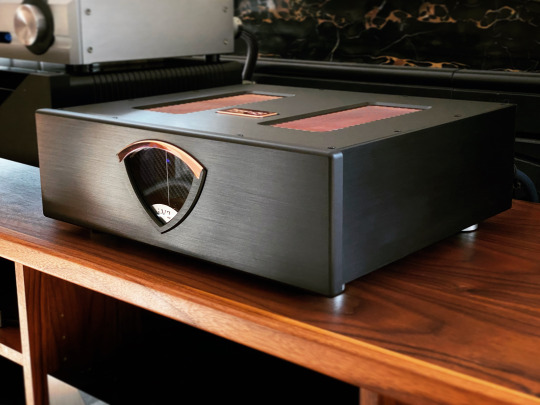
Legacy iv2 stereo amplifier
The Audiophile Weekend Warrior (TAWW)
TAWW Rating: 5 / 5
Class D power going toe-to-toe with Class A refinement
PROS: Nonexistent noise and distortion; tube-like midrange purity; full tonal balance with stellar bass; effortless power delivery; top to bottom refinement.
CONS: Ever-so-slight reductions in top-end extension, low-level resolution and dynamic life; slight mechanical buzz; binding posts could be nicer.
Class D (a.k.a. switching) amps have been around for decades, but really started to hit the audiophile scene in the early 2000′s. My first experiences around that time were a mixed bag, to say the least. A PS Audio HCA-2 sent my way for review blew its output stage when I powered it up. (In retrospect, my subwoofer setup may have been the culprit.) I wrote a review of the original NuForce integrated amp which, despite some sonic promise, felt like an unfinished product. The $30, battery-powered Sonic Impact "Class T" amp became a budget sensation, beguiling even some SET tube lovers, but its magic quickly ran out if you demanded more than a few watts from it. (The magic also ran out for its chip manufacturer Tripath, which went bankrupt.) And then there was a first-generation Bang & OIufsen ICEPower module, packaged inside an integrated amp by a high-end marque. It sounded pretty bad - dry, grainy, lifeless. How much was due to the ICEPower module vs. the rest of the amp is impossible to say, but it wasn't an auspicious introduction to the technology. Given this checkered past, it's little wonder Class D has been battling a reputation for sonic mediocrity with audiophiles. But new technologies make progress quickly, and the increasing number of rave reviews for the latest and greatest from Hypex, Pascal, ICEPower and others had me wondering... has Class D finally "made it" sonically? My time so far with the ICEPower-based Legacy i·V2 (USD $4,785) has been a pretty convincing yes.
Description
I won’t get into all the history and technical details of ICEpower technology - for that, I recommend this excellent audioXpress article. Of note is that ICEPower, after starting off as an independent subsidiary of Bang & Olufsen, split off into its own entity in 2016. The ICEedge controller chip at the heart of the Legacy amp’s 1200AS modules had been under development for 7 years and represents the latest and greatest iteration of ICEpower’s proprietary technology. It can scale in power from 50 to as many as 7,000 watts, and unlike some of those earlier Class D amps I tried, it has an array of sophisticated control and protection features to ensure smooth, bulletproof operation. In many months with the amp I’ve experienced zero clicks, thumps, signs of oscillation or other hiccups.
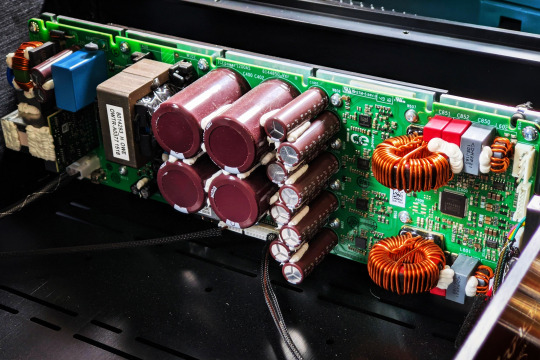
A kilowatt of clean power from this one board!
The i·V2 implements the ICEdge 1200AS modules as-is without any bespoke customizations to the circuit. (Note that this is the higher-performance mono 1200AS module, not the less expensive 1200AS2 stereo module that’s much more common.) Some other brands add their own input stage, but Legacy chief Bill Dudleston has opted to keep things stock and simple. You might be wondering, why can't I buy these modules myself then, slap them in a Chinese enclosure from eBay, save thousands of dollars and call it a day? The simple answer is ICEPower only sells them to OEMs, and forbids direct sales to consumers. But Mr. Dudleston also mentioned grounding of the modules as an area of special care, saying they were able to achieve a few dB's of additional noise performance through careful experimentation. At this level of power and performance, the little things matter.
Speaking of enclosures, the i·V2 has an extremely solid all-aluminum chassis with rose gold accent trim and plenty of ventilation around the modules. It's reassuringly hefty at 30lbs/13.6kg, so you wouldn't immediately guess it's a class D amp were it not for the 610W continuous (1000W peak) power rating. There's zero flex anywhere and while I have no idea how sensitive the modules are to vibration, knocking on the chassis gives a satisfyingly dull thud - much superior to anything you'd get on eBay or from lower-priced ICEPower resellers. There's a meter on the front, however this is neither a power meter as on McIntosh, nor a bias meter as on Pass Labs, but a measurement of the available AC power line voltage. There's a small pot on the rear panel to center it, and once calibrated it stays motionless during operation. I'm not really sure of the purpose of it, perhaps to monitor if your power lines are sagging when pulling in excess of the 1200 watts that the i·V2 is capable of delivering. The overall look is nicely done though probably a matter of taste... my wife not-so-affectionately nicknamed the amp "JARVIS" [sic] because the triangular meter reminded her of the yellow mindstone on the forehead of Vision, JARVIS's superhero embodiment in the Avengers movies. In what seems to be the fashion these days, the power/standby switch is located under the front panel, and there's an additional power switch at the AC inlet. One set of very standard 5-way insulated binding posts is provided along with balanced XLR and unbalanced RCA inputs. At this price point, I would have liked nicer posts, e.g. Furutech or WBT Nextgen. Not that there's anything wrong with the provided ones, and perhaps these posts were necessary to meet the extremely high power spec, but they feel decidedly prosaic and less pleasant to turn vs. the now-ubiquitous WBT's. A 12v trigger input rounds out the package.

Can’t get enough of rose gold? The i·V2 has you covered.
Setup
I tested the amp in two very different systems: the main reference rig, consisting of PS Audio DirectStream DAC ($6k), Gryphon Essence preamp ($17k) and Audiovector SR 6 Avantgarde Aretté ($25k) speakers; and a second system with RME ADI-2 DAC ($1200), Pass Labs XP10 preamp ($5k) and Silverline Prelude Plus ($2k). As you can imagine, really critical listening was done with the reference rig, but the second setup helped feel out how l the Legacy worked in a less expensive system. Interconnects are my usual mix of Audience Au24 SX and DH Labs Air Matrix; speaker cables were Audience Au24 SX or Furutech DSS-4.1. With the big rig, the Furutech was an excellent match; in the smaller system I used the Audience. I used only the balanced XLR inputs of the amp, so if your results differ from mine and you're using unbalanced RCA, that may be a factor. My system has been fully balanced for several years now and there's been no looking back.
The i·V2 is somewhat sensitive to the choice of power cord. I say "somewhat" because it certainly won't sound wrong or bad with a given cord, the stock one included, but nuances of its presentation can change - bass response, hall perspective, top end extension and soundstage proportion were the most noticeable aspects. For most of the time I was admittedly lazy and used a trusty Audience powerChord SEi without further thought. One day I finally swapped one of @mgd-taww's proprietary cords and found it to make a nice difference, which warranted some further tinkering. I found the otherwise superlative Furutech DPS-4.1 to not be a great match - it delivered tons of detail and a huge soundstage, but sounded slightly hollow tonally and lost some of the i·V2's endearing smoothness. The Audience Forte F3 (currently $149) was the big surprise - I actually preferred it to the more expensive powerChord. Audience graciously provided me with a set of Forte F3 cords a few years back when they debuted, but I haven't spoken much about them as I hadn't gotten them to click in my system. With most gear, the Forte was lighter, airier, but lacking some substance and transparency vs. the big-brother powerChord SEi. But with the i·V2, the Forte was surprisingly even better balanced and focused than the powerChord, with a more present midrange, more mid-bass punch and a bit more attack and air on the top end. Some systems and ears may still prefer the more laid-back perspective and silkier top end of the powerChord, but I really liked what the Forte did. At such a reasonable price point, it's a no-brainer upgrade over stock.

Direct connection from the RME DAC worked, but a preamp was much preferable.
A quick word about preamps: you need one with this amp. The RME DAC didn't sound particularly good driving the i·V2 directly and greatly benefited from the Pass Labs XP10. Moving up to the Gryphon Essence preamp was even better, and the i·V2 was more than resolving enough to reveal the Gryphon's substantial advantage in musical resolution and extension at the frequency extremes over the Pass Labs. As mentioned, many purveyors of Class D amplifier modules add their own flavor to the sound with an extra input stage (e.g. PS Audio adds a tube input buffer to the Stellar M1200) and this is one interesting way to go, but my preference would probably be to stick with a vanilla but more neutral ICEdge module as in the i·V2, then tune the system with a proper preamp.
Another setup observation: yes, Class D runs extremely cool vs. traditional amps, but they do still generate some heat and I was a bit surprised that the i·V2 always ran slight warm to the touch, similar to the Bryston 4B Cubed. And sure enough, I measured around 58W of power draw at idle - virtually identical to the Class AB Bryston, or an Ayre AX7e integrated for that matter. The big difference is that the i·V2 will deliver the vast majority of its musical power thereafter into the speakers and not the heatsinks, and temperature rose very little even during some heavy listening sessions. It will never get burning hot, but please don't stick it in an enclosed cabinet - as always, ventilation is still required. If you plan to keep the amp in standby, rest assured it draws only around 0.3W, and sound is delivered almost immediately upon power-up. It does require a few minutes to start sounding its best, but certainly warms up much faster than Class A or AB amps that generally require an hour or more to get close to their full potential.

I do wish the binding posts were fancier...
Finally, while the amplifier is absolutely dead quiet through the 92.5dB-efficienty Audiovector speakers, I noticed a slight buzzing sound from the amplifier modules themselves. It wasn't really audible from the listening position, but you could definitely hear it by the equipment rack. It's comparable to the slight buzz from a toroidal transformer that's dealing with a little DC on the power line, but I'm unsure that is the cause here vs. some intrinsic noise from the ICEPower's switching supply. None of my other components are having this issue at the moment, though in fairness, the Gryphons' exceptional quality transformers that are fully potted and enclosed set a benchmark for mechanical quietness. Not a major issue, just mentioning for completeness.
The Sound
Looking back at my listening notes from the first couple hundred hours of the i·V2's time in my system, it was apparent that I really needed to give the amp more time to break in. I should have known better, as my experience with audio gear employing high-speed switching circuits like DACs and Class D amps is they take a very long time to settle in. The DirectStream DAC needed at least 500 hours to sound its best, and despite cranking the Legacy amp into a 4-ohm dummy load for dozens of hours at a time with my break-in playlist, it took a couple hundred more hours before the Legacy started to click in the reference system. The second system is more forgiving and sounded good earlier on, but I'd still make sure to give the amp many, many hours before passing judgement.
Once that was out of the way, listening impressions were consistent and roundly impressive. Among the Legacy's more enviable characteristics: super low distortion; dead-quiet silence; terrific bass response; seemingly endless power on tap; smooth tonality with no discernible coloration; a surprisingly silky treble and full mid-bass; and a relaxed, slightly laid-back perspective that's a bit less immediate than my Class A amps, but still resolving and involving. Let's delve in...
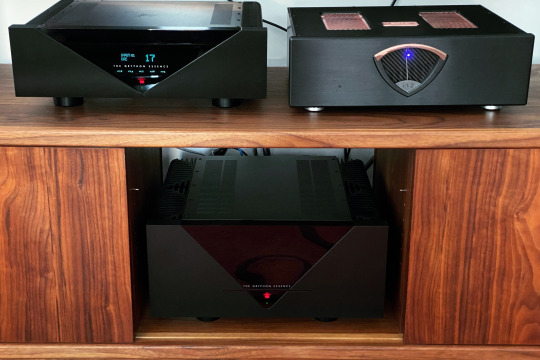
Head to head with the mighty Gryphon Essence
Tonally, the Legacy struck me as slightly mellower than my reference Gryphon Essence, at least with the Audiovector speakers. I hesitate to say the Legacy is "warmer," or the Gryphon is "brighter.” The Legacy, along with the Gryphon or the Bryston 4B Cubed have less overt tonal coloration compared to, say, the Pass XA30.5 (distinctly but not excessively warm), Valvet A4 Mk.II (more forward in the upper midrange) or Ayre AX7e (crisper and lighter). The upper frequencies were very slightly less prominent with the Legacy than the Gryphon, even though I’d never call the Gryphon bright or the Legacy rolled-off. There’s just a little less air in the soundstage, and instruments with strong HF energy like Donald Byrd’s trumpet in “Witchcraft” (Byrd in Hand, Qobuz 16/44) felt slightly curtailed vs. the ultra-open Gryphon. It might have more to do with the amps’ approach to harmonics than their inherent brightness, which I’ll get to later.
The midrange is smooth and balanced, with a purity that's a step above my aural memory of the Pass and Bryston. As with the treble, it has a sense of warmth and silkiness not for what it adds to the signal, but for what it doesn't. It’s so exceptionally free of any audible distortion that even the lovely Valvet sounded a tiny bit grainy and coarse by comparison. Given that I lauded the Valvet for its midrange purity relative to the Bryston 4B3, which in turn I also liked for its midrange quality, that’s saying something.
Class D amps typically have great bass, and the Legacy didn't disappoint. Earlier in the review period, it easily surpassed the Gryphon in weight and punch, making the Gryphon sound slightly anemic on tracks like Billie Eilish's “all the good girls go to hell” (Qobuz 24/44). It was also more neutral and controlled than the Pass while having even more punch. The Gryphon still has more texture, depth and musical resolution with my speakers, and more recently it has retaken the lead in overall bass response for reasons I'm still trying understand. Either the Gryphon has finally fully broken in its enormous bank of supply capacitors, or improvements to other aspects of the system (e.g. a 20A power line) have favored it. Given that many love the bass performance of Pass Labs and the Gryphon is considered world-class in that regard, the Legacy has to be considered superb, with both the power and refinement to satisfy music lovers across a wide spectrum of genres and tastes.
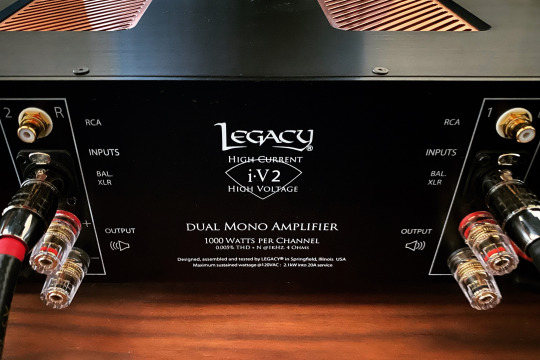
What really stands out about the i·V2 is how it can combine all of the above qualities with over 600 watts of continuous power, yielding a balanced presentation that's utterly composed regardless of volume level or material. The way it scales its refinement beyond ear-splitting levels makes most every traditional amp seem shouty, edgy or strained by comparison. While the Bryston 4B3 sounded better the louder I played it, it wasn't as smooth and detailed; the Pass XA30.5 got a bit lumpy and loose at the limit; the Valvet gets a little edgy and coarse at moderately high levels; and even the mighty Gryphon Essence can get subtly brighter as you ask more power of it. The Legacy is an effortlessly smooth operator, and I certainly didn't have a speaker on hand that could faze it in any way.
Tradeoffs
Resolution of fine detail is where the Class A stalwarts pull away from the Legacy. There’s a few aspects of reproduction where this exhibits: top-end extension, harmonic resolution, very low level detail and soundstaging, which I’ll attempt to detail...
The top-end is what I would call slightly soft. It's not rolled-off, nor did I find it "dark" as I've seen some people call it. It's more that a level of sparkle and sheen that is subtly omitted from the sound. Instruments like cymbals, triangles and trumpets still have realistic tonality, they just feel slightly softer around the edges. This also affects the feeling of harmonic completeness - the highest overtones of woodwinds are somewhat curtailed. This led my oboist wife to comment that the i·V2 made oboists she was personally familiar with sound even smoother and sweeter than real life, whereas the honesty of the Gryphon Essence gave a more realistic representation.
The Valvet A4 Mk.II and certainly the Gryhon Essence, and by aural recollection the Pass XA30.5, also capture a bit more of the ambient signature in a recording - the "hall" sound, the sense of performers in a space. It’s not that the Legacy is very lacking in this respect, but similar to early SACD players, it does still have a touch of the “velvet curtain” effect where below a certain threshold, subtle parts of the signal seem attenuated. This can also makes listening at very low levels a tiny bit muffled. Resolution is still excellent, at least on par with amps around the $5k price point, e.g. the Bryston 4B Cubed. A pair of Benchmark AHB2’s could be interesting competition, but I haven’t heard it, and it doesn’t have anywhere near the current capability of the Legacy.
The last area where I found the Class A amps superior was dynamic contrasts. Despite the Legacy being the most power amplifier I have ever used by a long shot, it actually didn't sound more dynamic at typical volume than the 50 watt Gryphon, or the 55 watt Valvet monoblocks. Sure, it will play much louder than they can, but loudness isn't the same as dynamics. The Gryphon and Valvet both had a bit more life, a bit more contrast in colors... I hate to say it, but more “PRAT.” I'd put the Legacy somewhere between these amps and the Bryston 4B Cubed, which had a greater tendency to flatten dynamic nuances. (Note: my speakers are quite efficient and tame, so I’d imagine this could be a very different story into something significantly under 90dB/watt and/or presenting a tougher load.)
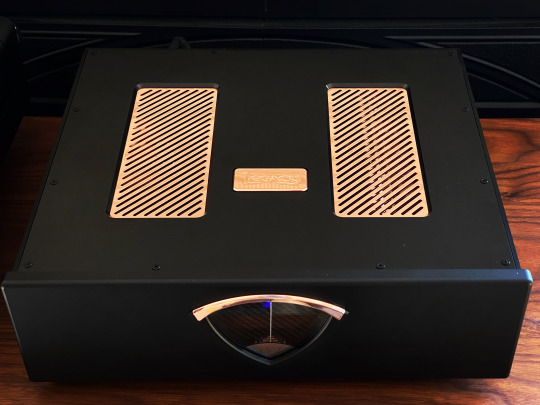
One more caveat to the above observations: it might be more speaker-dependent with the i·V2 than a typical linear amplifier. Interestingly, I found the i·V2 to kind of be the opposite in terms of speaker interactions and tonality to what I usually experience with my systems. The reference Audiovector speakers, with their ruthlessly revealing AMT tweeters and critically balanced tonality tend to be less forgiving of amplifiers than the much more affordable Silverlines with their soft-dome tweeter. However I actually found the i·V2 to bring out just a bit of upper midrange and lower treble prominence with the Silverline (not a bad thing per se), while sounding comparatively mellow with the Audiovectors. Load-dependent performance is a well-known challenge with the Class D topology, and while designers have found increasingly sophisticated means of mitigating it, it is probably still a factor here, albeit a much more nuanced one than in the past. I have to wonder if this variability is why one still hears of such wildly varying opinions of Class D amps... in any case, an audition with your preferred speakers is highly advisable.
Further Musings...
The Legacy i·V2's exceptional performance forced me to check my notions of fidelity. In terms of measured performance, it’s among the best I’ve experienced (along with the Bryston 4B Cubed), and my ears registered its sound as correspondingly pure and distortion-free. Could the Legacy's slightly smoother, less bright and less overtly dimensional perspective actually be more accurate than my other amps? It's been shown (by e.g. Nelson Pass) that some judicious 2nd order harmonic distortion can add a sense of dimensionality to a recording, which explains why tubes can sound so "holographic". In the tube case, I find this to be a euphonic (albeit lovely) deviation from the original recording. The Gryphon Essence is also a soundstaging beast, and while it’s far more neutral than any tube amp I’ve heard, could some of its dimensionality also be additive rather than accurate? Could something similar be said of the i·V2 slightly soft treble - is this actually the absence of distortion that exists in virtually all other systems, including the ones used to master recordings? Listening to a bright pop album, e.g. Dedicated by Carly Rae Jepsen (Qobuz 24/44), the i·V2 was certainly more listenable than the crisper and more sibilant Gryphon. On the other hand, the Gryphon has a bracing immediacy, a feeling of being pulled into the mix and enveloped by the music. The i·V2 by comparison is a little tame, a little reserved, perhaps even a tad muffled. Is that extra dynamic verve and contrast I hear from the Gryphon and other Class A amps real, or an artifact? Which is more accurate?
Because of the infinite number of variables in the recording and playback chain, there's likely no clear-cut answer. While no one buys a Gryphon or Pass Labs for the best specs, there’s no denying that the latest crop of Class D amps are on another level of measured performance from old-school Class A machinery. On the other hand, I do feel the i·V2 subtracts a few things from the signal. How much does that matter to your ears in your system? It's a close enough call that I can imagine circumstances of some preferring the Legacy to the Gryphon. For me personally, while I could happily live with the Legacy, I do inevitably find myself returning to the Gryphon for those extra nuances - the fineness of instrumental textures, the palpability of the soundstage, the dynamic inflections - the things that make hifi more evocative of the real thing.
I recently attended a lovely performance by The Cleveland Orchestra in their summer home, Blossom Music Festival. (Hurray for the return of live concerts!) When I returned home that evening, the Legacy was hooked up in the system. I put on a live recording of the Philadelphia Orchestra - not at all equivalent in venue or performance to what I had just heard, but bear with me - and it struck me that the tonality of the i·V2 was actually quite evocative of the real thing. Live orchestral performances have a ton of energy, and yet they sound so smooth and sweet compared to typical reproduced sound. The i·V2 captured that silkiness to a greater degree than I’ve heard in my system, but was lacking some of the edge and vitality. Switching to the Gryphon gave me more of the excitement of the live event, but tonally it wasn’t quite as spot on. At this point, we’re probably approaching the limits of conventional reproduced sound, so some tradeoff will be necessary. Which one is “better” may depend on your frame of reference. E.g. if you like the neutrality and balance of solid state amps, you'll likely find little missing from the Legacy's presentation; if you favor the tonal color, dynamic verve and larger-than-life presence of tubes, you may find the Legacy a little dull. The very fact that I'm having to finely parse these matters of fidelity and taste is a testament to the overall excellence and refinement of the i·V2. To accomplish that that with 610 watts on tap for under $5k is a significant milestone for Class D technology, and a remarkable feat of engineering.
I must mention the obvious ecological benefits of Class D over Class A - we are drawing literally hundreds fewer watts, we don't need to keep it running or warm it up for extended periods to sound good and we are generating far less waste heat. The electric bill and thus cost of ownership will also be appreciably less. On the flip side, the jury is still out on how long these amps will last, vs. a Gryphon or Pass Labs or Bryston that one can easily imagine humming along for 20+ years. As such, and as is often the case with newer and more commoditized tech, I'd expect resale value to be significantly lower than those marques. Just a couple extra things to consider when you're plunking down a not-inconsiderable amount of money on a piece of kit.
Conclusion

The Legacy i·V2, and Class D amplification more broadly, are emblematic of larger shifts in high-end audio technology. Just as solid state and digital audio took a while to hit their stride and gain legitimacy in the exalted (ok I'll say it, snobby) circles of the high-end, we've hit a point of maturity with Class D where technological sophistication and subjective fidelity can go hand in hand. The fact that I strained my ears comparing the i·V2 to a $24k Class A reference that is far and away the best amplifier I have ever heard in my system is all the proof I needed. For under $5k, the Legacy i·V2 delivers a balance of refinement and power that is unmatched by any conventional amplifier I'm aware of near its price point, and competitive in absolute terms with the better amplifiers under $10k and beyond, regardless of technology. It's a cut above what I heard from the Bryston 4B Cubed, and while I haven't had the Pass Labs XA.8 series in my own room, I would not hesitate to line it up against them. Many may still prefer the more overt musicality of the hot-running Pass behemoths, but my feeling is it'll be more a matter of personal taste or system matching, as opposed to one of absolute fidelity.
I have a few burning questions on my mind now. The first is how Legacy's implementation of the ICEdge 1200AS compares to other ones on the market - could you get similar or even better performance for less? The next one is how does the Legacy/ICEdge stack up against other Class D implementations from Hypex, Purifi, Pascal and others? And finally, I've also heard a lot of wonderful things about the Class H Benchmark AHB-2 from ears I trust. It too is compact, cool-running, superbly specified and relatively affordable, but utilizes a sophisticated implementation of traditional linear amplification technology. I would love to compare and contrast the Legacy with that amp.
In the meantime, I strongly endorse an audition of this amplifier without prejudice. It's a remarkable achievement in amplification - highly recommended!
1 note
·
View note
Text
At the beginning of March, the National’s Aaron Dessner traveled back to the United States from Paris, where he’d been living with his family, to shack up at Sonic Ranch Studio in Tornillo, Texas to work on the next Big Red Machine album with Bon Iver’s Justin Vernon. Those plans — obviously — soon shifted, as the reality of the COVID-19 pandemic set in. Dessner and his family were able to relocate to their home in upstate New York as lockdown orders went into effect, and the musician soon settled into a groove of homeschooling his kids and focusing fully on music in a way he hadn’t in a while, due to the National’s regularly rigorous touring schedule.
In the middle of what Dessner describes as one of the most productive moments of his career, Taylor Swift called.
A longtime and avowed fan of the National, Swift asked if Dessner wanted to try collaborating on a few songs remotely. He said of course, and asked if she was looking for anything in particular. He noted that he had plenty of material at the ready, but acknowledged he’d been in a more experimental mood, due to the Big Red Machine sessions; not to mention, Dessner added, he’d never really ventured into the pop world Swift has dominated for well over a decade. She told him to send everything he had.
“I think she was interested in the emotions that she feels in some of the music that I’ve made,” Dessner tells Rolling Stone.” So I just sent her a folder of things I’d done recently and was excited about. Hours after, she sent back a fully written version of ‘Cardigan.’ It was like a lightning bolt struck the house.”
Over the next few months, Dessner and Swift crafted the bulk of Swift’s eighth studio album, Folklore, which was released today, July 24th, after being announced the day before. Folklore is yet another mesmerizing musical move from Swift — a shift in sound, style and palette towards a vaster indie sound (à la, of course, the National) that still feels distinctly Swift-ian, as if she’s been making music like this her whole career. Lyrically, too, the record finds Swift playing with character and myth in new ways that — befitting the album’s title — recall the great American folk tradition.
Dessner wasn’t the album’s only collaborator; Swift wrote several songs with regular producer Jack Antonoff, as well as songwriter named William Bowery, who doesn’t seem to have much of an internet footprint. Vernon also contributed to two songs, singing on one of the album’s many stunners, “Exile,” while Dessner’s brother and National bandmate, Bryce Dessner, helped orchestrate it with a mix of musicians scattered around the globe (none of whom even knew what they were playing on when they recorded their parts).
Dessner spoke with Rolling Stone about working with Swift, their instant chemistry, how the album developed under a thick cloud of secrecy and more.
When Taylor first reached out, did she have a specific vision in mind for the album?
She was a bit cryptic. I didn’t know that we were actually working on a record for quite a while. It just seemed that she was seeking me out to collaborate. And then we were both feeling very inspired by it. Once there were six or seven songs that we had written over a couple of weeks, she said, “Hey can we talk?” Then she said, ‘This is what I’m imagining,’ and started to tell me about the concept of Folklore. Then she mentioned that she’d written some songs at an earlier stage with Jack [Antonoff], and they felt like they really fit together with what we were doing. It was a very inspiring, exhilarating collaborative process that was almost entirely remote. Very sort of warp speed, but also something about it felt like we were going toe-to-toe and in a good pocket.
After “Cardigan,” how did these songs develop and do you think she pushed you in any new directions as a songwriter?
When you’re working with someone new, it takes a second to understand their instincts and range. It’s not really conscious. She wrote “Cardigan,” and then “Seven,” then “Peace.” They kind of set a road map, because “Cardigan” was this kind of experimental ballad, the closest thing to a pop song on the record, but it’s not really. It’s this emotional thing, but it has some strange sounds in it. “Seven” is this kind of nostalgic, emotional folk song. Even before she sang to it, I felt this nostalgia, wistful feeling in it, and I think that’s what she gravitated towards. And “Peace,” that just showed me the incredible versatility that she had. That song is just three harmonized bass lines and a pulse. I love to play bass like that — play one line then harmonize another, and another, which is a behavior I stole from Justin Vernon, because he’s done that on other things we’ve done together. And actually, that’s his pulse, he sent me that pulse and said, “Do something with this.” But when she wrote that song, which kind of reminds me of a Joni Mitchell song over a harmonized bassline and a pulse, that was kind of like, “Woah, anything can happen here.” That’s not easy to do.
So, in the morning I would wake up and try to be productive. “Mad Woman” is one I wrote shortly after that, in terms of sound world, felt very related to “Cardigan” and “Seven.” I do have a way of playing piano where it’s very melodic and emotional, but then often it’s great if whoever’s singing doesn’t sing exactly what’s in the piano melody, but maybe it’s connected in some way. There was just some chemistry happening with her and how she was relating to those ideas.
“Epiphany” was something she had an idea for, and then I imagined these glacial, Icelandic sounds with distended chords and this almost classical feeling. That was another one where we wrote it and conceived it together. She just has a very instinctive and sharp musical mind, and she was able to compose so closely to what I was presenting. What I was doing was clicking for her. It was exhilarating for us, and it was surreal — we were shocked by it, to be honest [Laughs]. I think the warmth, humanity and raw energy of her vocals, and her writing on this record, from the very first voice memos — it was all there.
Do you think that chemistry might’ve had something to do with her being a National fan, and you being a fan of her music?
We met Taylor at Saturday Night Live in 2014, or whenever that was that we played and Lena Dunham was hosting. We got to meet her, and that was our first brush with a bona fide pop star. But then she came to see us play in Brooklyn last summer and was there in a crazy rainstorm, like torrential downpour, and watched the whole show and stayed for a long time afterwards, talking to me and my brother. She was incredibly charming and humble. That’s the nice thing about her, and a lot of people I’ve met that have that kind of celebrity. It’s great when you can just tune it out and be normal people and chat, and that’s how that felt. So, we knew that she was a big fan, and we really got into the 1989 album. Our Icelandic collaborator, Ragnar Kjartansson, is a crazy Swiftie. So we’ve kind of lived vicariously through him. I’ve always been astonished by how masterful she is in her craft. I’ve always listened to her albums and put them in this rarefied category, like, “How did she do that? How does anybody do that? How do you make ‘Blank Space?’” There was an element that was intimidating at first, where it just took me a second to be like… Not because I think her music is better than what we’ve done, but it’s just a different world.
Were there particular songs, albums or artists the two of you discussed as reference points for this album?
“Betty,” which is a song she wrote with William Bowery, she was interested in sort of early Bob Dylan, like Freewheelin’ Bob Dylan, I think. “Epiphany,” early on, felt like some weird Kate Bush-meets-Peter Gabriel thing. I think we talked a little about those things, but not a lot. Actually, I think she really trusted me as far as my instincts to where the music would ultimately go, and also the mixing process. We really wanted to keep her voice as human, and kind of the opposite of plastic, as possible. That was a bit of a battle. Because everything in pop music tends to be very carved out, a smiley face, and as pushed as possible so that it translates to the radio or wherever you hear it. That can also happen with a National song — like if you changed how these things are mixed, they wouldn’t feel like the same song. And she was really trusting and heard it herself. She would make those calls herself, also.
You mentioned William Bowery — who is he?
He’s a songwriter, and actually because of social distancing, I’ve never met him. He actually wrote the original idea for “Exile,” and then Taylor took it and ran with it. I don’t actually know to be totally honest.
We’ve been trying to track him down, he doesn’t have much of an internet presence.
Yeah, I don’t fully know him, other than he wrote “Betty” and “Exile” with her. But you know she’s a very collaborative person, so it was probably some songwriter.
So it’s not an alias for anyone?
No, no, no. I mean, I don’t know — she didn’t tell me there was a “Cardigan” video until literally it came out, and I wrote the song with her [laughs]. So I don’t know. But I’m pretty sure he’s an actual songwriter. She enjoys little mysteries.
“These are kind of these folkloric, almost mythical tales that are woven in of childhood, lost love, and different sentiments across the record.”
With the National, you and your brother write the music, Matt Berninger adds the lyrics, and then you fuse it — was it a similar process on Folklore?
Taylor is very collaborative in that sense that, whenever she sent a voice memo, she would send all the lyrics and then ask me what I thought. And sometimes we would debate certain lines, although generally she’s obviously a strong writer. So she would ask me if I liked one line, and she would give me alternate lines and I would give her my opinion. And then when she was actually tracking vocals, I would sometimes suggest things or miss things, but she definitely has a lot of respect for the collaborative process and wants whoever she’s writing with to feel deeply included in that process. It was nice, and was a back and forth, for sure. And she would sometimes have ideas about the production if she didn’t like something, especially. She would, in a tactful way, bring that up. I appreciated that, too, since I wanted to try to turn over every leaf, take risks and sometimes get it wrong. That always takes a second, to get over and then you start again.
You mentioned earlier that once you had six, seven songs, she was able to describe a concept behind the album. I’m curious what that conversation was like.
She would always explain what each song was about to me, even before she articulated the Folklore concept. And I could tell early on that they were these narrative songs, often told from a different… not in the first person. So there are different characters in the songs that appear in others. You may have a character in “Betty” that’s also related to one in “Cardigan,” for example. And I think that was, in her mind, very, very important. It doesn’t seem like, for this record at least, that she was inspired to write something until she really knew what it was about. And I think I’m used to a more — at least lately — impressionistic and experimental world of making stuff without really knowing what it is. But this was more direct, in that sense. That was really helpful, to know what it was about and it would guide some of the choices we were making.
Every time she would send something, she would narrate a little bit, like how it fit, or what it was about. And then when she told me about Folklore as a concept, it made so much sense. Like “The Last Great American Dynasty,” for example, this kind of narrative song that then becomes personal at the end — it flips and she enters the song. These are kind of these folkloric, almost mythical tales that are woven in of childhood, lost love, and different sentiments across the record. It was binding it all together and I think it’s personal, but also through the guise of other people, friends and loved ones.
You were working in secret — how did that affect the process? Was that a difficult burden?
It was. I was humbled and honored and grateful for the opportunity and for the crazy sort of alchemy we were having. But it was hard not to be able to talk openly with my usual collaborators, even my brother at first. I didn’t know if I could really tell him, because we normally… Ultimately, he helped me quite a bit, he orchestrated songs. But we always help each other. But eventually, we figured out how to do it. Towards the end of the process, I said to Taylor, ‘I really feel that I need to try a few experiment and try to elevate a few moments on the record because we have time, and we’ve really done a ton of work here, and it all sounds great, but I think we can go even further.’ And then she said, ‘Well what does that mean?’ And I explained how that would work, and the way that we work. Our process is very community-oriented, and we have long-time collaborators that we have a good understanding with. So I was able to say, to my friends, ‘This is a song I’m working on, I can’t send it to you with the vocals, and I can’t tell you what it is, but I can explain what I’m imagining.’ And the same with my brother, he knows my music so well that that was very easy for him to just take things that we were working on, add to that, and do his kind of work. So it was all remote and everyone was in their corner and we were shipping things around. It was incredibly fast because of that, because you didn’t have eight people needing to come to the studio. You had eight people working simultaneously — one in France and one in L.A. and one in Brooklyn. This is how it went, and it was fun. We got there.
When were you able to tell everyone who contributed that this was the Taylor Swift record, what was their reaction?
You can imagine. I think they realized it was something big because [of] the confidentiality, and they were like, ‘It could only be a few things.’ I couldn’t tell them until, basically, when she announced it. Just in the moments after she announced it, I basically told everyone. I was like, ‘By the way…’ And they were thrilled. Everyone’s thrilled. Nobody seemed mad, everyone was thrilled and honored. Even Justin Vernon had not heard anything else except “Exile,” even though the pulse of that song “Peace,” he gave that song to me. It was important to have it be a surprise, and you know how it can be with someone in her position, with all the speculation, and she’s always under a lot of pressure like that. So it was really important to the creative freedom she was feeling that this remained a secret, so she could just do what we were doing.
Being such longtime friends and collaborators with Justin, what was it like hearing “Exile” for the first time? His voice and Taylor’s together?
He’s so versatile and has such a crazy range, and puts so much emotion… Every time he sings when I’m in his presence, my head just kind of hits the back of the wall. That’s the same on this song. William Bowery and Taylor wrote that song together, got it to a certain point, then I sort of interpreted it and developed a recording of it, and then Taylor tracked both the male and female parts. And then we sent it to Justin and he re-did obviously the male parts and changed a few things and also added his own: He wrote the “step right out” part of the bridge, and Taylor re-sang to that. You feel like, in a weird way, you’re watching two of the greatest songwriters and vocalists of our generation collaborating. I was facilitating it and making it happen, and playing all the music. But it was definitely a “Wow.” I was just a fan at that point, seeing it happen.
Are there any moments that really stick out to you as particularly pivotal in shaping the sound of this record?
The initial response. When we first connected, and I sent a folder of music and Taylor wrote “Cardigan,” and she said, “This is abnormal. Why do you have all these songs that are so emotional and so moving to me? This feels fated.” And then she just dove into it and embraced this emotional current. And I hope that’s what people take out of it: The humanity in her writing and melodies. It’s a different side to her. She could have been every bit as successful just making these kinds of songs, but it’s so great that she’s also made everything that she’s ever made, and this is a really interesting shift, and an emotional one. It also opens other doors, because now it’s kind of like she can go wherever she wants, creatively. The pressure to make a certain kind of… bop — or whatever you want to call it — is not there really anymore. And I think that’s really liberating, and I hope her fans and the world are excited by that because I am. It’s really special.
30 notes
·
View notes
Text
international year of plant health
hi. i made a playlist of a snapshot of the stuff i’ve listened to this year if you’re looking for some recommendations! xoxo mae
https://open.spotify.com/playlist/0VkfnggwpC1TEj2wsaHyZr?si=4JJd6Z-kRoCHuHypRtWK3g
1. little simz - might bang, might not 2. jean deaux - recipe! 3. logic - open mic\\aquarius iii 4. spittzwell - the lesson 5. ivy sole - kismet 6. vel the wonder - fine art 7. megan thee stallion - shots fired 8. kari faux - look at that 9. rico nasty - own it 10. flo milli - beef flomix 11. kodie shane - 2 many 12. kali uchis - ¡aquí yo mando! 13. tkay maidza - shook 14. bree runway - atm 15. yung baby tate - i am 16. almondmilkhunni - grapefruit 17. princess nokia - soul food y adobo 18. bosco - attention 19. kiana ledé - movin. 20. diamond white - secondhand 21. queen naija - i’m her 22. danileigh - mistreated 23. parisalexa - 2 optimistic 24. qveen herby - farewell 25. jhené aiko - p*$$y fairy (otw) 26. chloe x halle - forgive me 27. kehlani - water 28. umi - pretty girl hi! 29. rimon - i shine, u shine 30. disclosure - birthday 31. phora - cupid's curse 32. roy ayers - synchronize vibration 33. thundercat - unrequited love 34. thelonious coltrane - perfect timing 35. [ k s r ] - passion 36. alina baraz - more than enough 37. alayna - glowing 38. savannah cristina - self love 39. paloma ford - rain 40. nakala - she interlude ii 41. orion sun - lightning 42. jaz karis - hold you 43. cleo sol - when i'm in your arms 44. keiyaa - do yourself a favor 45. alicia keys - me x 7 46. yazmin lacey - morning matters 47. be steadwell - succulent 48. daniela andrade - k.l.f.g. 49. yung lean - dogboy 50. bladee - sun 51. blackwinterwells - algae 52. sullii - moonlight 53. misogi - heart chained 54. aminé - talk 55. tobi lou - lingo starr: drunken master 56. busta rhymes - look over your shoulder 57. 2 chainz - southside hov 58. atmosphere - the future is disgusting 59. meltycanon - moody blues 60. alfred. - sheeshfred 61. love-sadkid - ephemeral 62. jay squared - vision like you! 63. tuamie - you needed time you said 64. oatmello - blue 65. wun two - a noite 66. kuranes - calm 67. omaure - drama 68. dust and moonlight - sleeping or sinking 69. phlocalyst - image 70. ocha - r33 71. sugi.wa - love u 72. palm - memories of winter 73. goosetaf - tripwire 74. bryzone_ybp - the count 75. orancha - smoky banana 76. evil needle - midnight 77. eevee - romance 78. chief. - can't explain 79. ngyn - aerith 80. fujitsu - move on 81. meitei - nami 82. swum - breezy 83. chris mazuera - perspective 84. jinsang - maybe 85. tesk - cascades 86. saib - nautica 87. mf eistee - uprising 88. kaskade - when you’re dreaming 89. tatsuya maruyama - love you - lo-fi remix 90. towerz - before i gave in 91. baechulgi - abyss 92. underbelly - glitchwater 93. notsure - icecoffee 94. yutaka hirasaka - arise 95. akisai - ecossaise 96. nom tunes - missing piece 97. sweet dove - on the viewless wings 98. park bird - new place, same people 99. city girl - ji-eun's favorite 100. katie dey - loving 101. mary lattimore - sometimes he's in my dreams 102. teen daze - peaceful groove 103. pacific coliseum - turquoise 104. tycho - outer sunset 105. [.que] - glimmer 106. lights & motion - separated hearts 107. roger eno - celeste 108. talsounds - opening 109. alva noto - xerrox voyage 110. 36 - stasis sounds for long-distance space travel (stage 2) 111. stan forebee - bedscape 112. daniel avery - illusion of time 113. arbee - 2sum - charlie dreaming remix 114. okada takuro - waterfront (up-01) 115. gabriel ólafs - lóa - bing & ruth rework 116. warmth - the creek - mixed 117. rhucle - rev 118. com truise - surf 119. sarah davachi - still lives 120. gastón arévalo - sur les traces des explorateurs 121. peter bark - ascension 122. kara-lis coverdale - flutter 123. totally enormous extinct dinosaurs - brockley 124. green-house - peperomia seedling 125. four tet - green 126. morimoto naoki - aru 127. kaitlyn aurelia smith - remembering 128. dj python - te conocí 129. ocoeur - glow 130. christina vantzou - snow white 131. alonefold - strange rainbows 132. savoir adore - dancing temples 133. tengger - water 134. suzanne ciani - a sonic womb pt. 3 135. mogwai - major treat 136. this will destroy you - entrance 137. sleepmakeswaves - time wants a skeleton 138. elsa hewitt - rebird 139. ulla - i think my tears have become good 140. aether - she isn't here 141. zoe polanski - the last frontier 142. lyra pramuk - witness 143. ana roxanne - a study in vastness 144. julianna barwick - nod 145. the leaf library - about minerals 146. gia margaret - barely there 147. lucy gooch - my lights kiss your thoughts every moment 148. briana marela - forgiveness 149. loma - homing 150. mree - open arms 151. ellis - saturn return 152. alexia avina - fit into 153. fenne lily - to be a woman pt. 1 154. noble oak - evaporate 155. mint julep - blinded 156. rush week - best laid plans 157. mini trees - slip away 158. winter - bem no fundo 159. yumi zouma - cool for a second 160. laura veirs - burn too bright 161. terry vs. tori - keepsake box 162. castlebeat - shoulder 163. candace - still phase 164. tiny deaths - if i'm dreaming 165. lydia - heavy 166. caspian - nostalgist 167. nova one - lovable 168. corey flood - heaven or 169. hazel english - off my mind 170. bantug - dizzy 171. tops - colder & closer 172. the hidden shelf - miracles 173. ruru - 99 174. widowspeak - even true love 175. cheerleader - providence 176. wild nothing - blue wings 177. deradoorian - corsican shores 178. strfkr - second hand 179. mint field - contingencia 180. ringo deathstarr - god help the one's you love 181. no joy - dream rats 182. white poppy - orchid child 183. keeps - swiggum 184. flung - firstly zested 185. the bilinda butchers - rie 186. sipper - kid 187. radiator hospital - imposter syndrome 188. addy - equinox 189. boyo - dogma 190. alexandra savior - the archer 191. phoebe bridgers - chinese satellite 192. soccer mommy - circle the drain 193. routine - numb enough 194. quarter-life crisis - comfortable 195. madeline kenney - sucker 196. layne - linnea 197. wilsen - align 198. pynkie - you 199. bandanna - ghost home 200. waxahatchee - can’t do much 201. crisman - portrait 202. liza anne - i wanna be there 203. purr - gates of cool 204. honey cutt - hung up on me 205. the beths - out of sight 206. the ophelias - grand canyon 207. sjowgren - flip phones 208. haim - gasoline 209. thanya iyer - i forget to drink water (balance) 210. sad13 - good grief 211. porridge radio - give/take 212. lannds - not in a good way 213. katie von schleicher - wheel 214. hey cowboy! - detective farmer brown 215. tombo crush - pink 216. eliza moon - tell me / why'd you 217. anna mcclellan - raisin 218. this is the kit - this is what you did 219. snarls - walk in the woods 220. blushh - deal with it 221. long neck - cicada 222. chloe moriondo - ghost adventure spirit orb 223. momma - biohazard 224. varsity - runaway 225. land of talk - footnotes 226. bully - stuck in your head 227. diet cig - stare into the sun 228. expert timing - gravity 229. slow pulp - track 230. maddie jay - shakes 231. beabadoobee - together 232. luna aura - crash dive 233. sorry - perfect 234. torres - good grief 235. partner - honey 236. beauty queen - this time around 237. maggie lindemann - knife under my pillow 238. bryde - paper cups 239. mundy's bay - sleep away the summer 240. squirrel flower - red shoulder 241. mourn - stay there 242. dream wife - so when you gonna... 243. illuminati hotties - superiority complex (big noise) 244. l.a. witch - true believers 245. hinds - burn 246. beach bunny - cuffing season 247. suzie true - idk u 248. bacchae - hammer 249. peach kelli pop - stupid girl 250. oceanator - heartbeat 251. pins - read my lips 252. best coast - different light 253. muncie girls - take steps 254. kailee morgue - this is why i'm hot 255. beach slang - let it ride 256. silverstein - take what you give 257. new found glory - scarier than jason voorhees at a campfire 258. the lawrence arms - quiet storm 259. mikey erg - bon voyage 260. pet symmetry - had a name, don't remember it 261. thank you, i'm sorry - backpack life 262. ratboys - alien with a sleep mask on 263. joyce manor - leather jacket 264. jeff rosenstock - scram! 265. the aquabats! - aliens and monsters! 266. the used - the lighthouse 267. hidden hospitals - how amazing 268. dikembe - all got sick 269. time spent driving - trust no 1 270. the casket lottery - more blood 271. record setter - someplace 272. emma ruth rundle - out of existence 273. gulfer - blurry 274. options - don't mind 275. i love your lifestyle - stupid 276. orchards - stealing your sleep 277. no tongues for quiet people - lake house lake house 278. into it. over it. - hollow halos 279. mountains for clouds - full disclosure 280. joan of arc - destiny revision 281. no thank you - saturn return 282. the front bottoms - camouflage 283. ride your bike - make like a tom and cruise 284. dragon inn 3 - yer brothers 285. the goalie’s anxiety at the penalty kick - jars filled with rain 286. mansions - laser beams 287. waveform* - hello goodbye 288. owen - headphoned 289. cassino - tacoma 290. ajj - normalization blues 291. penelope scott - sweet hibiscus tea 292. angel olsen - (new love) cassette 293. trace mountains - fallin' rain 294. johanna warren - part of it 295. frances quinlan - lean 296. tomberlin - hours 297. samia - triptych 298. field medic - better way 299. adrianne lenker - my angel 300. jack m. senff - another day 301. lomelda - polyurethane 302. rosie carney - high and dry 303. brigid mae power - i had to keep my circle small 304. overcoats - new shoes 305. anna burch - not so bad 306. hop along, queen ansleis - the cactus 307. mandy moore - easy target 308. laura marling - held down 309. lisa loeb - doesn't it feel good 310. trixie mattel - gold 311. lilly hiatt - move 312. molly tuttle - sunflower, vol. 6 313. sarah jarosz - pay it no mind 314. katie heckel - help you mend 315. katie pruitt - my mind’s a ship (that’s going down) 316. in love with a ghost - trans rights 317. snail's house - imaginary express 318. isuka hino - dreamin' adventure!! 319. 4s4ki - nexus 320. lapix - loneliness 321. you - painter 322. aice room - dreary planet - yukiyanagi remix 323. zekk - oxygen 324. lu-i - loved happiness 325. synthion - volt switch 326. sanaas - polestar - junk remix 327. mameyudoufu - fluffy 328. awfuless - redemption 329. rejection - around you 330. toriena - getting into a pose 331. cosmo@bousoup - mow*mow*abduction!!! 332. yunosuke - ziqqurat 333. android52 - lovin', scratchin' 334. サクラsakura-lee - nobody else 335. desired - emotions 336. mikazuki bigwave - sakimashita bloomin'!! 337. skule toyama - smooth 338. adrianwave - goodbye 339. macross 82-99 - melt 340. cape coral - 707 hotline 341. 80kidz - heat 342. night tempo - baby 343. yaffle - lng, before 344. greyl - let me be with you 345. serph - palmtop tiger 346. happy kuru kuru - natsu no hi no labyrinth 347. couple n - earmie 348. airuei - magic sign 349. somunia - non player girl - nyankobrq 2p ver. 350. cosmicosmo - those that we once loved 351. maeshima soshi - the terminal 352. kijibato - 1room 353. yuc'e - ghost town 354. neko hacker - erased 355. jam2go - apotrope 356. mizuki ohkawa - cosmic cleft 357. singto conley - flora 358. 2tonedisco - shoelaces 359. cy8er - もしもしじゃぽん 360. nayuta - connect 361. t+pazolite - himitsu cult 362. milkoi - higher, higher, and then... 363. freezer - caramel rain (sanaas remix) 364. kotonohouse - pitter, patter 365. aika - superstar 366. yukiyanagi - love overdose 367. nanahira - twinkle password 368. ducky - hyper bloxxd 369. porter robinson - something comforting 370. moshimo - シンクロ 371. bish - スーパーヒーローミュージック 372. scenarioart - it's all right 373. base ball bear - ポラリス(c3 mix) 374. majiko - エスカルゴ 375. akaiko-en - ジャンキー 376. the peggies - weekend 377. lovely summer chan - more light 378. polkadot stingray - sp813 379. shishamo - フェイバリットボーイ 380. aimer - run riot 381. österreich - i'll take you everywhere 382. sora tob sakana - 夜間飛行 383. the shes gone - ふためぼれ 384. aimyon - marshmallow 385. cö shu nie - supercell 386. kensei ogata - violin case 387. せだい - yellownola 388. yonige - あかるいみらい 389. bearwear - i think 390. hitsujibungaku - ロックスター 391. cidergirl - 飛行船 392. room97 - faq 393. she's - ugly 394. bbhf - tokenai mahou 395. alisa takigawa - 夢 396. satomoka - glints 397. radwimps - shinsekai 398. pinoko - コリドー街 399. helsinki lambda club - you are my gravity 400. lucky kilimanjaro - 君とつづく 401. dish// - sauna song 402. zombie-chang - snooze 403. mizuki ohira - 無重力 404. みゆな - 歌おうよ 405. iri - come back to my city 406. aya a.k.a panda - i miss u 407. chelmico - disco (bad dance doesn't matter) 408. seiko oomori - 絶対彼女 409. yaeji - my imagination 상상 410. daoko - zukizuki 411. eill - night d 412. cifika - déjà vu 413. yeye - step in time 414. saevom - just like i dreamed then 415. cheeze - today's mood 416. stella jang - reality blue 417. younha - one day of twenty 418. jeong eun ji - whoo 419. fromm - aliens 420. crush - tip toe 421. heize - 1/1440 422. femm - level up 423. awich - poison 424. jessi - nunu nana 425. (g)i-dle - luv u 426. summer soul - tinder 427. taeyeon - worry free love 428. boa - l.o.v.e 429. fromis_9 - feel good (secret code) 430. faky - re:chase me 431. monsta x - night view 432. twice - up no more 433. loona - hide & seek 434. wjsn - pantomime 435. iz*one - fiesta 436. exid - ddd jpn ver. 437. gfriend - crème brûlée 438. april - lalalilala 439. weki meki - 100 facts (cool eng. ver.) 440. momoland - starry night 441. steve aoki - play it cool 442. bts - dynamite 443. sakurako ohara - shine on me 444. sumin - zaza♡ 445. onepixcel - lagrima 446. little glee monster - i feel the light 447. celeina ann - purikura 448. アイラヴミー - そのまんま勇者 449. okkyung lee - here we are (once again) 450. luca - lune 451. hakushi hasegawa - hikari no rock 452. haruka nakamura - your sonnet 453. itoko toma - shade 454. rina katahira - hoshizora* 455. ichiko aoba - easter lily 456. satoko shibata - 変な島 457. 角銅真実 - 6月の窓 458. 熊川みゆ - sixteen 459. 眉村ちあき - 緑のハイヒール 460. 竹内アンナ - striking gold 461. saucy dog - film 462. kaede - -ending- night blue 463. aseul - paradise 464. 박혜진 park hye jin - like this 465. charlotte is mine - road movie 466. plastic plastic - ฮัม - (hum) 467. clams - shiny rider 468. seventeen years old and berlin wall - no paradise 469. nuit - nightbirds 470. fulusu - ghost 471. rammells - sennengo 472. stargaze shelter - emulation (mode:totonee) 473. ヨルシカ - 昼鳶 474. nakamuraemi - 大人の言うことを聞け 475. kenshi yonezu - ひまわり 476. tk from ling tosite sigure - reframe 477. penguinrush - 色彩 478. lee jin ah - candy pianist 479. mei ehara - どちらにピントを 480. jizue - because 481. mouse on the keys - room 482. fox capture plan - stand my heroes - groove version 483. ryutist - girls 484. yeti let you notice - bouquet 485. tricot - 真っ黒 486. madison cunningham - giraffe 487. covet - atreyu 488. floral - maybe not one day 489. envy - eternal memories and reincarnation 490. baths - mikaela corridor 491. sufjan stevens - run away with me 492. fractures - feel 493. the 1975 - frail state of mind 494. dan mason ダン·メイソン - everytime i cry 495. brothertiger - cannonball 496. porches - rangerover - bonus track 497. tame impala - instant destiny 498. washed out - paralyzed 499. pink skies - portland 500. so below - bone 501. purity ring - silkspun 502. llll - breathless 503. slow magic - somewhere 504. kasbo - lune 505. cloudnone - let the music in 506. jody wisternoff - blue space 507. drama - hold on 508. satin jackets - meridian getaway 509. direct - opal 510. lane 8 - road 511. baile - jlm 512. yuni wa - starships 513. nora van elken - sakura 514. geotheory - the day i left you 515. yota - hazy paradise 516. spencer brown - chance on us 517. the avener - conscious shadows 518. kalbells - mothertime 519. bella boo - in love 520. kirara magic - neon 521. mija - digressions 522. cuushe - emergence 523. transviolet - rituals 524. keep shelly in athens - steady to go 525. young ejecta - ah ha 526. annie - in heaven 527. lany - good guys 528. dominic pierce - glad xoxo 529. tender - what you're missing 530. alice jemima - binge love you 531. kitty - baby pink 532. faye meana - like honey 533. lunadira - am i gonna die? 534. loony - white lie 535. justine skye - fav 536. wafia - good things 537. victoria monét - jaguar 538. malia civetz - love thing 539. keiynan lonsdale - i confess my love 540. deaton chris anthony - tuethday 541. kallitechnis - body&soul (ish d remix) 542. talitha. - ineedsomeone 543. keke palmer - thick 544. kesha - birthday suit 545. l.e.j - pas l'time 546. selena gomez - rare 547. the aces - daydream 548. jessie ware - mirage (don’t stop) 549. joan - try again 550. melanie c - blame it on me 551. astrid s - dance dance dance 552. little mix - holiday 553. justin bieber - yummy 554. ariana grande - positions 555. bea miller - feel something different 556. lady gaga - rain on me (with ariana grande) 557. raye - regardless 558. the weeknd - hardest to love 559. andrea valle - lovergirl 560. k/da - the baddest 561. allie x - susie save your love 562. terror jr - dinner plate 563. shawn wasabi - halo halo 564. benee - snail 565. sevdaliza - oh my god 566. gupi - modest 567. six impala - sweetsweetsweetlikebubblegum 568. charli xcx - i finally understand 569. golin - hanakotoba 570. shygirl - freak 571. madge - ethanol 572. arca - afterwards 573. kelly lee owens - re-wild 574. ari mason - pangaea 575. gabrielle aplin - dear happy 576. taylor swift - the 1 577. awfultune - buds 578. sneaks - scorpio on your side 579. izzy camina - kill your local indie softboy 580. mxmtoon - ok on your own 581. wens - giant bat 582. billie eilish - my future 583. tash - when you leave 584. fletcher - the one 585. silver sphere - ghosts! 586. tei shi - ok crazy 587. dounia - sucked all the fun 588. tatiana hazel - carmen sandiego 589. magdalena bay - killshot 590. kllo - insomnia 591. leisure suite - closer 592. morgan saint - i dreamt that i knew you 593. ayelle - got love 594. michi - escondida 595. lyrica anderson - lyfted 596. sasha sloan - lie 597. niki - plot twist 598. sarah reeves - heart first 599. salt cathedral - caviar 600. chelsea cutler - sad tonight 601. rituals of mine - heights 602. e^st - flight path 603. sara diamond - great together 604. phem - stfu 605. carlie hanson - daze inn 606. lauren aquilina - latest ghost 607. caroline rose - command z 608. misterwives - oxygen 609. ella vos - turbulence 610. austra - i am not waiting 611. triathalon - you 612. phoebe ryan - icimy 613. katzù oso - kiss u better 614. luwten - control 615. raveena - heartbeat 616. oohyo - 2020 617. oklou - another night 618. jouska - bring you back 619. fleur east - easy to love 620. soft glas - overbite 621. jaden - muted sunrise 622. snny - better to leave it 623. saint mela - alkaseltzer 624. mia gladstone - ego 625. helena deland - truth nugget 626. oh wonder - oceansize 627. steven padin - sashimi 628. kacey johansing - i try 629. treasureseason - spinning plate 630. landshapes - drama 631. tennis - matrimony ii 632. pomplamoose - morning waterbug 633. soko - being sad is not a crime 634. the big moon - barcelona 635. shamir - diet 636. knox fortune - static 637. carly rae jepsen - let's sort the whole thing out 638. real estate - the main thing 639. hayley williams - roses/lotus/violet/iris 640. nada surf - something i should do 641. bombay bicycle club - is it real 642. the seshen - faster than before 643. thao & the get down stay down - how could i 644. marla hansen - path 645. christine and the queens - la vita nuova 646. half waif - siren 647. malena zavala - ritmo de vida 648. bendik - himmelen 649. hanna järver - kalmar slott 650. frida sundemo - anything 651. kate nv - telefon 652. ambar lucid - questioning my mind 653. coco reilly - mirror 654. ghostly kisses - lydian 655. kacy hill - told me 656. lianne la havas - can't fight 657. donna missal - how does it feel 658. felivand - gone 659. jordana - divine 660. empress of - void 661. banoffee - ripe 662. vanessa carlton - i can't stay the same 663. fiona apple - heavy balloon 664. poppy - concrete 665. rina sawayama - stfu!
6 notes
·
View notes
Text
The Vain Emperor of the Track
>It’s time.

Ladies and gentlemen, start your engines.
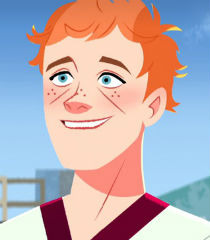
This has been a long time waitin’. I can’t wait!

Same here. He’ll pay for what he’s done.


Playing with two people’s hearts like that is unforgivable. It’s time for him to face the fist of justice!
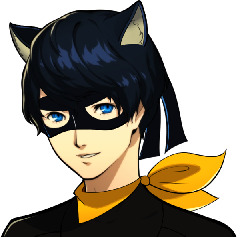
Then we’re off! Let the race begin!
>Mona becomes our van.
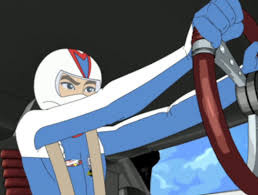
Let’s race!
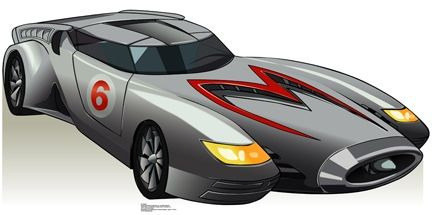

Here we go!
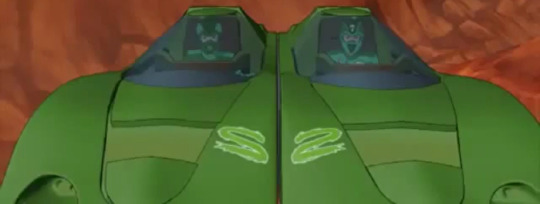
>With that, we go on our way to take Trey Sterling’s heart.
>The penthouse overlooking the track is were very special guest to the school usually stay. This time, Sterling Sterling and his son, Trey, were staying here. They were trying to remain as calm as they can after receiving our calling card this morning.

I’m sure the police are doing whatever they can to get to the bottom of this. Don’t worry, son.

I’m sure, Dad. I’m not that worried... Although, these Phantom Thieves are quite tenacious... Especially the one called Crow.
Mr. Sterling: Now, now, things will be fine. Right now, you should get some sleep. We’ve got a lot to do later on. Good night.
Trey: Good night.
>Mr. Sterling goes off to his room while Trey stayed in the study. Everything was quite... Until...
?????: Good, we don’t want Daddy getting in the way.
Trey: !
>A red wave passes over. When it was done, the study had been replaced with a podium, a place where the Roman Emperor would sit in the Colosseum. Outside, the the track of the Colosseum of Vanity was roaring with excitement... And Trey had been replaced with his Shadow.
Shadow Trey: You have arrived.
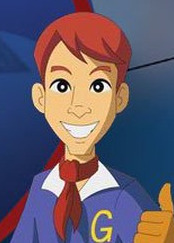
You bet we did! And we’re here to win!
Shadow Trey: I’d like to see you try.

Believe us. We will.
Shadow Trey: Very well. To the track!
>With that, Shadow Trey leaves.

Okay, so we all remember the plan, right?

While Trey’s Shadow is distracted by his race with Zack, Joker, Panther, Queen, Crow, Wolf, Speed, X, Slice, and Dice, we will sneak the Treasure away before anyone notices. That’s pretty much it.
Lucy: Exactly.
Carmen: Good to hear. I still wish Player could be here. Or at least have contact with him.

Sorry, Red, but in the Metaverse, the only hacker you have is yours truly.

And we’re all happy that you’re here, Oracle.

We’re all counting on you.

Good luck today, Oracle.
Oracle: Thanks, you guys.
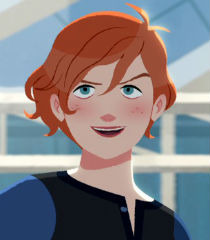
Me, Oracle, Connor, Chim-Chim, and Lucy will be in the pits over the radio.

I will join you as well. If anything happens to Joker, I want to be able to help.
Joker: Thank you, Fox. Wish us luck.

Then let’s get to it! Are we ready?
Everyone: Ready!
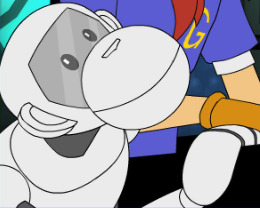
*Chirp*
>With that, we go our separate ways. Me, Fox, Panther, Queen, Crow, Wolf, Slice, Dice, Speed, X, Zack, Oracle, Lucy, Conor, Chim-Chim, and Ivy go to the track while Mona, Skull, Noir, Violet, Sophie, and Carmen go to retrieve the Treasure.
>Out on the track...
Oracle: Okay, Lucy, Conor, and Chim-Chim prepped the Mach 6, the Shooting Star, and Duel Aces and Ivy prepped Lydia (Zack’s car). So I did some tuning of my own.

Really? I can’t wait to see it.
>Just then, a large trailer was being pulled up to us... by a small car.


Hi, everyone! It’s been a while!
Panther: (happy) Jose, it’s good to see you again.
Zack: (confused) You know this kid?
Queen: Yes, he’s a friend of us.
Oracle: With a little technical know-how and the power of cognition, I managed to fix up some vehicles just for you. I didn’t want to store them in the garages here out of fear someone would sabotage them and they can’t really exist outside the Metaverse, so I asked Lavenza if I can store them in the Velvet Room. I also asked Jose to bring them here.
Jose: They look pretty good. Not as good as my ride, but still, nice machines.
>We go to the back of the trailer and Oracle opens them. Inside are four cars. One car had an Arsene-like design, the second had a Carmen-like design, the third had a Robin Hood-like design, and the fourth had a Valjean-like design.

WOW! These look so cool, Oracle!
Oracle: (smirking) That’s not all. Each of your cars also has a special feature. Joker, your car, Phantom Flyer, has a grappling hook with wires strong enough to pull the car or other things. Conor even helped me with laser sawblades. Use with care.
>I get in the Phantom Flyer. I drive it to the front of Jose’s car and fire the grappling hook at it. With ease, I manage to pull both Jose’s car and the trailer a decent 10 feet. Then, I activate the laser sawblades and Jose takes out a cinderblock. He moves it towards the sawblades and the block is cut with ease.

This is awesome, Oracle.
Oracle: Panther, your car, Flaming Kitty, has the same cloaking technology the Mach 6 and the Shooting Star have. But aside from that, it can also change its appearance to look like anything. Even other cars. It also has flamethrowers.
>Panther drives the car out. When she activates the cloaking technology, it becomes invisible. Then, it reappears as the Mach 6, then the Shooting Star, and then as Lydia before changing back. Next, she activates the flamethrowers which perfected roasted some marshmallows Jose just happened to have.

I wish I could show my mom! She would love this!
Oracle: Crow, your car, Freedom’s Strike, has the same camouflage technology like Panther’s. It can also shoot arrows and lasers and it also has sawblades both steel and laser.
>Crow drives the car out. It shot a few arrows and lasers into a target Jose set up. Then, Crow activates the laser sawblades and cuts a cinderblock. Then, the car changes its Robin Hood-like design to a Loki-like design. Then, steel sawblades come out and cuts the target in half.

(changing the car back to its original design) Quite amazing, Oracle. You know me all too well...

A little too well for my taste.

Yeesh, I think all that time you spent undercover really messed you up.
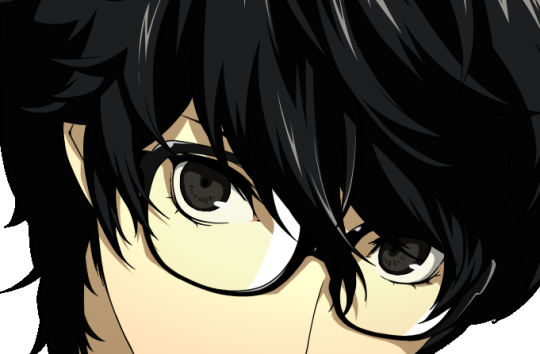
Either that or the connection made between you and the target.
Oracle: Now, Wolf, your car, Howling Silver, is built like a tank and is virtually indestructible. Even a wrecking ball can’t destroy it. And it has sonic canons for blasting your way through just about anything.
>Wolf drives his car out. Jose brought out his hammer and gave the car a good hard whack. But the car was just fine. Then, Wolf fires a sonic blast which shatters a stack of glass jars Jose set up.
Wolf: (excited) Sweet! I’m so going to talk to my superiors about making something like this in the real world.
Oracle: Good luck. I want to make cars for the others, but I’ll think about it after they finish their lessons.
Wolf: Probably good.
Dice: Hold on, Queen’s racing, too. How come she doesn’t have a car?
Queen: I’ve decided I’m just going to ride Agnes. She’s the closest to being a car.
Lucy: Is that even allowed?
Queen: There’s no rule against it.
Lucy: Fair enough.
>We take our cars to the track and we ready ourselves.
Racer Shadow: Yo, babe! Where’s your car?

It’s right here.
>Queen goes Third Tier.
Queen: PERSONA!


>Queen got on Agnes as Shadow Trey came on the track with his golden car.
Shadow Trey: Friends, Bostonians, countrymen, lend me your ears! Today will make the day that the Racer Family is finally put in their place! And I take down the legendary Phantom Thieves of Hearts! After this race, no one will ever question again who is the greatest person to ever live! Now, let us begin!
Announcer: Now watch as our most glorious emperor, Trey Sterling, goes up against the soon to be disgraced Racer Family and the Phantom Thieves!
>Shadow Trey comes to us.
Shadow Trey: Hope you’re ready to lose. That’s all you’ll ever be good for.
Speed: We’ll see about that.
Zack: You bet. I won’t lose to you this time.
Announcer: All drivers to your cars, please! All drivers to your!
Shadow Trey: (pointing and clicking) Later, Big Z.
>Zack was trying to hold back his rage as Trey’s Shadow left.
Ivy: Don’t let him get to you, bro. Remember what happened last time.
Zack: R- Right. That was the old Zack. The new Zack is way more cool under presser.
>Ivy left to join Oracle, Fox, Lucy, Conor, and Chim-Chim... I could tell Zack was still mad.
Joker: Are you alright?
Zack: It’s just... Ever since we were kids, Trey has always gotta do me up. Be better than me. And he does it with his old man’s money and then rubs it in my face especially. Why’s he gotta be like that?
Joker: I suppose we’ll know once we take his Treasure.
Zack: Still, I just can’t stand it. He’s worst than havin’ to eat fish.

>I know how you feel. >>You're the better person.
Zack: Come again?
Joker: Trey thinks he can buy his way into victory, but that’s not the same as having real talent. There are some things that even money can’t solve. And I speak from experience. Shido thought that because of his position, he could get away with anything, and look where that got him. The same thing will most likely happen to Trey.
Zack: You really think that?

I do. So to me, aside from Skull, that makes us brothers.
Zack: That’s... That’s the nicest thing I’ve ever heard. Hey, does that make Ivy like your sister, too?
Ivy: (who heard us and came over with Fox) We’re a package deal. You get one of us, you get both of us. Just remember that we ain’t leavin’ Carmen.
Joker: Don’t worry, you’re not going anywhere from her.
Zack: ... (smiling) Thanks, Joker. I owe you one.
Joker: Think nothing of it.
Zack: No really, you gotta let us thank you in some way. How ‘bout this, you change Trey’s heart, I might teach how to drive not just cars, but other stuff, too. How does that sound?
Joker: Well, if Mona where here, he’d say that would come in handy.
Fox: I agree. You never know when we might need to escape in just a car. You’ve already shown to be good on a motorcycle and you’re so close to passing your diver’s test with help from your father, I think it wouldn’t hurt to try other things.
>I think about it. I would be helpful to learn how to operate other forms of transportation.

Alright, you’re on.
Ivy: Then we have a deal.
Zack: You bet.
>Me and Zack do a fist bump together.
I am thou, thou art I… Thou hast acquired a new vow.
It shall become the wings of rebellion that breaketh thy chains of captivity.
With the birth of the Shine Persona, I have obtained the winds of blessing that shall lead to freedom and new power…
Confidant: Zack & Ivy
Arcana: Shine (This Arcana is made up for this Confidant.)
Rank: 1
Ability: The Getaway Driver
Zack and Ivy will teach you better driving skills to use in the Metaverse.
Announcer: Last warning: All drivers to your cars, please! All drivers to your cars!
Joker: (putting the mask back on) Ready?
Zack: Ready as we’ll ever be.
>So, we get in our cars and Fox and Ivy rejoin the others.
Ready... Set... GO!!!
>And we’re off!
>Meanwhile, with the other at the podium, they were searching for the Treasure.
Skull: It’s gotta be here somewhere. We all sat that light thing right here.
Mona: He must have hidden it knowing someone would take it while he’s racing.
Sophie: I can sense it, too.
Carmen: I wish Oracle could have stayed with us.
Noir: I’m sure if we look harder, we can find it. Just think, where would someone as narcissistic as Trey would hide something that he believes gives him power?
Mona: My guess is somewhere really obvious. Someplace where he just can’t help but show it off to everyone.
Carmen: Maybe that?
>Carmen was pointing to some Shadows that were carrying something covered by a gold tarp.
Cognitive Being 1: There’s the prize for the winner of the race!
Cognitive Being 2: I sure wish I could enter to win it, but no one can beat the emperor. No one.
Cognitive Being 3: Still, whoever wins that... Oh, who am I kidding? Emperor Trey’s got this race in the bag!

I guess that’s it.
Violet: How are we going to get it? There are too many eyes watching.
Carmen: I think I can help with that. Oracle did a tune up to my tools. They should help us.
>Carmen pressed something on her coat and she turns invisible.
Noir: (taking out a small potion bottle) Panther gave us this camouflage potion. It should last us long enough to grab the Treasure and get out.
Carmen: Sounds simple enough... What’s the catch?

Straight to the point, huh?
Noir: Well, we might still have to fight a few Shadows along the way. Including the Palace Ruler. It’s usually unavoidable. So be ready.
Carmen: Thanks, I will.

Then here we go!
>Noir sprinkles the potion on herself and the others and they are hidden from view. They and Carmen go to take the Treasure.
>Meanwhile, back on the track, the race was raging on. A Shadow nearly rams me to the side, but luckily, I dodged it.
Oracle’s Voice: Be careful, Joker. I think Trey’s Shadow payed those guys to take you guys out.
Joker: No doubt. They don’t look like they’re going to let us leave this race with our lives.
Speed: Dad said and Uncle Rex used to deal with stuff like this all the time. I think we can make it through.
Ivy’s Voice: Just try not to do anything reckless.
Lucy’s Voice: Good luck with that. If there’s one thing you should know about Speed and X, “reckless” is their middle name.
Speed: Actually, my middle name is Daisuke.
Ivy’s Voice: Seriously?
X: Well Dad said it was either that or Pops.
Queen: Better watch it, we got one coming!
>A Shadow comes up to me. It transforms.


Bring it! Persona!


Tutorial
You have just entered a Race Battle.
If you have seen Persona 5 Scramble: The Phantom Strikers, this battle is similar to the battles there.
When you attack a Shadow, it gets knocked backwards. When its HP goes to 0, it will be defeated. However, if you get attacked, you will be the one knocked backwards. If your HP goes to 0, it is game over.
>Garuda attacks with Garudyne. Luckily, I dodge it. Arsene uses One-shot Kill. Garuda is knocked back and loses a lot of HP due to his weakness to Gunfire. Garuda drives (or flies or whatever he’s doing in this race) back up and attacks me, sending me back a bit. I drive back up and Arsene uses One-shot Kill again. Then, I attack with my own gun. He is knocked back good. Garuda tries again to attack me, but I dodge it. Arsene uses One-shot Kill again and Garuda is gone.
Joker: That was close.
>Then, I notice Flaming Kitty driving up.
Tutorial
When one of your teammates is in view, you can pass the baton to them.
During this time, the one who passed the baton will have time to regain HP and SP.
>I pass the baton to Panther.
Panther: Okay, it’s my turn now! Persona!


>A Shadow come up to her and transforms.

>The Oni tries to attack Panther, but she dodges it. Carmen uses Agilao. The Oni uses Snap. Panther is sent back a bit. Carmen uses Marin Karin and the Oni is Brainwashed. Oni does not act. Panther then uses the car’s flamethrower. It had a Burning effect. After snapping out of it, Oni attacks Panther with Giant Slice. It was a critical hit and Panther is knocked backwards. Thankfully, she recovered and Carmen used Diarama. The Oni tries to use Giant Slice on Panther again, but she dodges it. Carmen then uses Marin Karin again and Oni is once again Brainwashed. The Oni slows down. Then, Carmen uses Agidyne and the Oni is gone.
Panther: Yes! That’s cool!
>Queen passes ahead of Panther and she passes the baton to her.
Panther: Good luck!
Queen: Thanks.
>A Shadow comes up and transforms.

>The Shiki-Ouji uses Psio. Queen is weak to it and it really knocks her back. She recovers and drives onwards. Agnes uses Freidyne. The Shiki-Ouji is knocked way back. Queen takes this as an opportunity and uses Freidyne again. The Shiki-Ouji grives back up again and uses Double Snap. It was a critical hit and Queen is knocked back. Fortunately, she recovers quickly. Agnes then uses Diarahan. Shiki-Ouji uses Psio, but Queen dodges it. Agnes then uses Freidyne and Shiki-Ouji knocked backwards. Queen decides to go bigger and Agnes uses Atomic Flare. The Shiki-Ouji drives up again, but is real weak. Shiki-Ouji uses Taunt, but it didn’t work. Agnes uses Atomic Flare again and the Shiki-Ouji is gone.
Queen: So glad you’re on our side, Agnes.
>Queen spots Crow in Freedom’s Strike. Queen passes the baton to him.
Crow: My turn!
>A Shadow drives up to him and transforms.
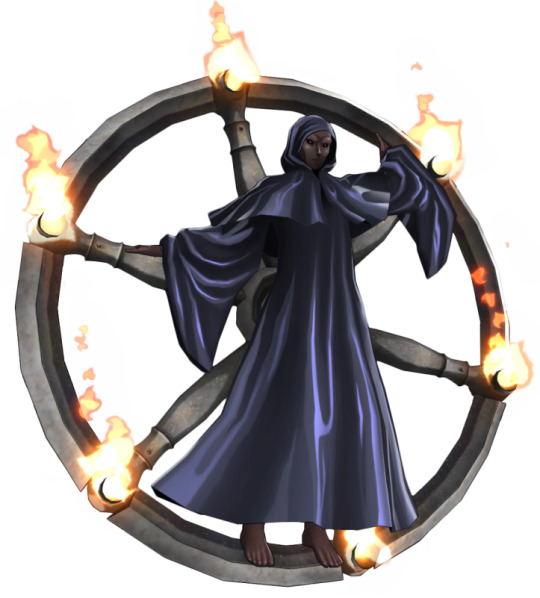
Crow: My skills exceed yours! Persona!


>Throne uses Makougaon. Fortunately, Crow resisted. Robin Hood uses Eigaon. Throne is knocked back. Throne tries to attack Crow, but he dodges it. Robin Hood tries to use Mamudoon, but it misses. Throne uses Makougaon. Crow resists again. Robin Hood uses Eigaon. Throne is knocked back. Then, Robin Hood uses Megaton Raid. Throne moves back up again and Throne attacks. This time, it was a critical hit and Crow is thrown back. Crow drives up again and Robin Hood uses Eigaon. Throne is knocked back. Then, Robin Hood uses Megidola. Throne drives up again and uses Makougaon. Crow resists again. Robin Hood uses Eigaon, but Throne dodges it with Evade Curse. Throne hesitates. Robin Hood uses Mamudoon. Throne is knocked back. Then, Robin Hood uses Megidola. Throne drives back up again and attacks. Robin Hood uses Megaton Raid, but Throne dodges it. Throne attacks again and it is a critical hit. Throne attacks. Crow manages to regain the lead.
Crow: Very well. It seems that Instant Kill didn’t do much... I guess I’ll have to do this the hard way.

PERSONA!


>Freedom’s Strike also changes. Loki uses Eigaon. It was super effective and throws Throne backwards. Then, Loki uses Laevanteinn. The now weakened Throne drives back up again and tries to use Makougaon. However, Crow dodges it with Evade Bless. Loki uses Eigaon again and Throne was gone.

Good. And not a moment too soon.
>Crow sees Wolf driving Howling Silver. Crow passes the baton just has changes back from Black Mask Mode.
Crow: (in cool down) We’re almost there. Keeping going!
Wolf: Rodger!
>Another Shadow drives up and transforms.

Wolf: So you’re the last one between us, Sterling, and the lead. Alright, bring it on! Persona!

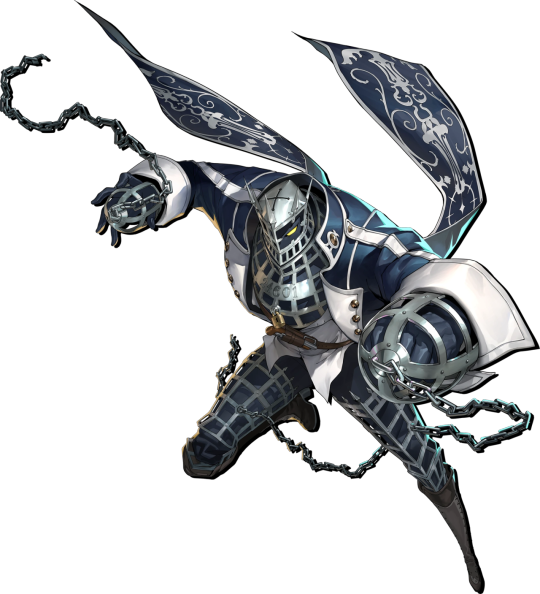
>Baal uses Charge. Valjean uses Heat Riser. Baal uses Ayamur. It was a critical hit and Wolf was knocked backed. Baal just hesitated. Wolf drives back up and Valjean uses One-shot Kill. Baal uses Panta Rhei. Valjean uses Trible Down. Baal uses Panta Rhei again. Valjean uses One-shot Kill. It was a critical hit and Baal is knocked way back. Valjean then uses Megidola. Baal recovers and uses Revolution. Valjean uses Agneyastra. It was a critical hit and forces Baal way back. Valjean then uses Megidolaon. Baal drives back up and uses Ayamur. It was a critical hit and Wolf is forced back. Baal then uses Panta Rhei. Wolf manages to drive back up with little HP. Valjean uses Heat Riser. Baal tries to use Ayamur again, but Wolf dodges it. Valjean uses Megidolaon and Baal is gone.
Wolf: Yes!
Oracle’s Voice: Great work, you guys! All that’s left is Trey’s Shadow.
Wolf: Right!
Joker: Let’s hope the others are doing great with the Treasure.
>Back with Carmen and the others, they managed to get close to the Treasure.
Carmen: (looking under the tarp) This looks like a job for the laser cutter.
>Carmen cuts open a hole big enough for her and the others to get in. They go inside.
Carmen: Got it.
Mona: This is the Treasure alright.
Sophie: It certainly has that vibe.
>They sneak away until they were in the clear. The Treasure was a shiny golden racing trophy.

What a surprise.
Skull: And I thought Kamoshida was bad. This just takes the cake.
>Carmen then takes a closer look at the trophy...
Carmen: (surprised) I see, that explains it.
Skull: What’s up, Red?
Carmen: Something real interesting.
>Back on the track, I managed to catch up to Wolf thanks to Slice, Dice, Speed, X, and Zack.
Wolf: Good luck to you all.
Joker: Thanks.
Slice: Me and Dice will take care of things in the rare.
>Me, Speed, X, and Zack drive up to Trey’s Shadow.
Shadow Trey: Well, look who finally decided to show up. I knew hiring those idiots wouldn’t help.
X: Goes to show you that good help is hard to find.
Shadow Trey: Fine, if you want something done right, do it yourself.
Speed: X and I will take care of Trey if he tries anything. Joker, Zack, think you can handle it?
Zack: You bet. I’ve been waiting for this for a long time.
Ivy’s Voice: Just try to focus. This isn’t like all the races we’re use to.
Joker: Don’t worry, he won’t be alone this time.
Zack: Thanks, Joker. Let’s do it!
>I nod... and go Third Tier.
Joker: PERSONA!

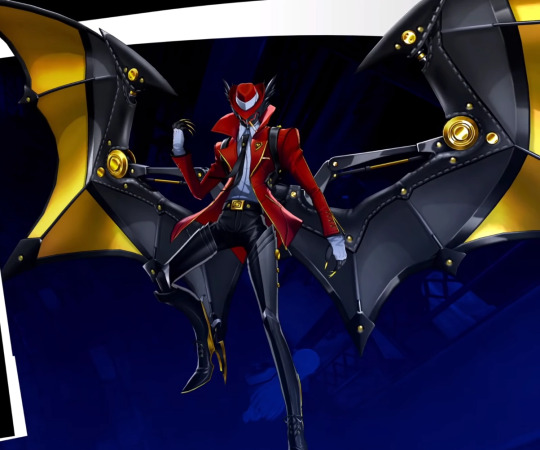
>Shadow Trey tries to use Brain Shake on me, but I dodge it. Raoul uses Concentrate. Shadow Trey uses Psiodyne. Raoul uses Phantom Show which puts Shadow Trey to Sleep.
Joker: Now’s your chance! Attack!
Speed: Here I come!
>I fling the Mach 6 forward with the Phantom Flyer’s grappling hook. Then, Speed attacks with his car’s laser sawblades. Speed drives back into position. Shadow Trey uses Taunt. I fall under Rage. I attack Shadow Trey with my car’s laser sawblades. Shadow Trey uses Psiodyne. It was a technical hit. I snap out of it and Raoul uses Eigaon. Shadow Trey tries to use Terror Claw, but I dodge it. I equipped Raoul with the One-shot Kill Skill Card and he uses One-shot Kill. It was a critical hit.
Joker: We get another one! Go!
X: This is for Annalise!
>I fling the Shooting Star forward and X rams Shadow Trey’s car, sending it back a bit. X moves back into position. Shadow Trey uses Brain Shake. Fortunately, I wasn’t Brainwashed. Raoul uses Concentrate. Shadow Trey uses Marin Karin. It didn’t work. Raoul uses Eigaon. It took a lot of Shadow Trey’s HP. Shadow Trey uses Sukukaja. Raoul uses One-shot Kill, but Shadow Trey dodges it. Shadow Trey then uses Marin Karin and I become Brainwashed. I nearly attack Speed. Shadow Trey uses Psiodyne. It was a technical hit. I snap out of it and Raoul uses Concentrate. Shadow Trey tries to use Brain Shake, but I dodge it. Raoul uses Phantom Show and it puts Shadow Trey to Sleep.
Joker: Get ready for another one! Just one more after this!
Zack: Here I go!
>I fling Lydia forward and Zack attacks Shadow Trey, sending him further back. Zack moves back into position.
Shadow Trey: (now really angry) I’m not done yet! Let me show you what happens when you cross me! I release upon you the deadly sin of vanity! You have no means of escape, human! The fraudulence of mankind shall bring forth ruin!
>Shadow Trey uses Distorted Vanity. Raoul uses Concentrate again. Shadow Trey uses Psiodyne. I’m knocked back a lot. Shadow trey then uses Skull Cracker. Fortunately, I didn’t get Confused. Raoul uses Phantom Show and Shadow Trey is Asleep again.
Joker: Now to finish this race!
>I give the final blow.

>After that, Shadow Trey was now back behind us. Then, I notice something.

Zack! Look!
>Zack was way ahead of us. He was in first place.
Ivy’s Voice: Go for it, bro! Go for it!
Zack: This is for you, sis! And everyone in Southie!
>Then, in a zoom... it was over. Zack crossed the finish line and won the race.
Cognition 1: (in disbelief) No way! Emperor Trey actually lost!?
Cognition 2: They must have cheated somehow.
Cognition 3: Actually, now that I think about it, doesn’t Emperor Trey do the same thing?
Cognition 4: Hey, you’re right! He paid those racers to kill those other racers!
Cognition 5: We’ve been supporting a cheater this whole time!
Cognitive Spectators: (outraged) Trey Sterling is a crook! A SPOILED LITTLE BRAT!
>Later at victory lane, Shadow Trey comes to us weakly.
Shadow Trey: It’s... It’s not possible... I should have won... I always win...
Wolf: Only because you paid those racers to lose with your father’s money. That’s not how you gain victory.
Shadow Trey: But, it’s my victory. I’m a proud son of Boston. I’m Boston Proud. Even the trophy says so.
??????: Does it really?
>Carmen and the others come to us with the trophy. She showed us the plaque at the bottom. Engraved on it was Trey’s name, but above it was another name that was chiseled out. I could definitely make out Zack’s first name, but his last name was completely unreadable.
Shadow Trey: The trophy? My trophy.
Carmen: I don’t think so. You clearly didn’t earn this. It was Zack’s.
>Shadow Trey looked like he was ready to attack one of us, but instead, he just drops to his knees and begins sobbing. We weren’t sure how to react... Then Zack comes over to Shadow Trey. He comes down to him.
Zack: (actually sympathetic towards his nemesis) Just... Why? Why do ya do this? Especially towards me and my sister?
Shadow Trey: (looking to him) ... You... You really want to know?
>Zack nods.
Shadow Trey: Look at you. You appear to be such an amateur, but the truth is... You were the better racer. You did a lot of things that were better than me. Compared to you, I was the real amateur. This was something even my father knew. He just wanted to see me happy. So, he decided to do whatever it took to make me happy. To make sure that I get what I want. From that very day at kindergarten, I convinced myself that my father and his money were the only way to get it. I love my father. He is a great man. If anyone could help me get my way, it’s him.
Noir: But that’s not how it works. There are somethings that you have to earn for yourself.
Shadow Trey: And make myself look like a fool? Like him? (points to Zack) Never. In this world, you take what you want the first chance you get. That’s why I’ve been so hard on Zack and Ivy. Because I didn’t want anyone to think that any way, despite our backgrounds... we would be the same. But we’re not. We... are rivals.
Zack: (shocked) ...
Speed: So you’re saying all this time, you and Zack could have been friends?
Shadow Trey: Maybe that’s another reason why I’ve always looked down on you. So that whenever you lose to me, you would realize that the only way to beat me was to befriend me. Though I wouldn’t be caught dead associating with someone from lower class, I could have changed all that.
Zack: But... We coulda been friends without all that.
Shadow Trey: !
Zack: Well, I don’t know. I’m still processin’ this. But bein’ so high and mighty around me and Ivy wouldn’t have made us friends. Just bein’ a good sport and welcomin’ anyone who shares the dream.
Shadow Trey: ...
Zack: I know you just wanted to be the best so that everyone would like you, but it never really hurts to show everyone who the real Trey Sterling is. You don’t need to hide behind your daddy’s wealth and power. You’ve got somethin’ that he could never get with his money.
Shadow Trey: ... What is that?
Zack: ... Beats me. It ain’t my life that needs fixin’. (offers his hand) So get up. Try to find just what you really can do.
Shadow Trey: ...
Joker: Listen to him. He may not look like a goofball, but he’s a wise goofball.
Carmen: He’s cares about others besides himself. I guess that includes you.
Shadow Trey: ...
Joker: It’s like we were saying...

You can’t buy talent or friendship. You ear it.
>Shadow Trey just sat silent for a bit. He thought of what we said... Then, he takes Zack’s hand and is pulled up.
Shadow Trey: I’m sorry. I now know that what I did was wrong. I shouldn’t have treated you so terribly. And I also shouldn’t have played Bobby or Annalise. I don’t deserve either of them.
X: (whispering) That’s for sure.
Shadow Trey: For a while, I’ve always wanted to be as famous as my former idol, August Gaunt, as well loved by everyone as my old pen pal from Arizona, and a popular as... You, Akechi.

What!?
Shadow Trey: Yes, I know who you are. I suppose the me in the real world knows, too, but hasn’t fully figured it out yet. And even if he has, I doubt he’s going to say anything. Even he wouldn’t believe it. After all... It came to him in a dream. As did Augusts and his pen pal.
Crow: Then you know that my popularity as what you think.
Shadow Trey: I think so. I guess popularity, fame, and being well loved are very different things.
Carmen: You just have to find a way to connect them in a good way. Start with doing something that will get you well loved. For starters, apologizing to those two hearts you played... And maybe donate to a good charity.
Skull: Like the B.O.M.G.T.M. Foundation.
Crow: Or the Worldwide Engineering Brigade.
Shadow Trey: Yeah, I think those would be good starts.
>With that, Shadow Trey returns to his true self and we take our own leave as the Palace vanishes.
>To be concluded...
1 note
·
View note
Note
🌱
Is there a song that changed me in some way?
Well, Les (Mr. Blank), I don’t know if it has something to do with being born before 1990 or being an American, but I am basically one of those people where my entire personality was going to be determined by music from the get-go. To be clear, I am fucking old. I was a teenager in the 90’s, and I have to qualify any answer I give by trying to convince you that people then were just no where near as cool as kids now. You know, if you didn’t have a cool older cousin or sister and just grew up lonesome in the suburbs, you were basically left to magazines and MTV to try to figure out what’s cool. This is sort of a lie. Turns out there were plenty of cool people, I was just a dork. So these are a dork’s answers.
Yes. Lots of songs changed me, not that that means much. I will be honest and give dumb answers that are the truth. I feel like I went through puberty the moment I first heard Chris Isaac’s “Wicked Game” and asked to stay behind in my Dad’s pick-up truck and listen to the rest of the song.
I had a major life epiphany in my Mom’s car being very suicidal and depressed when AC/DC’s “You Shook Me All Night Long” came on and I just groaned and was like (I was 11) “Is this another sad song???” Obviously no. That suggests some derangement on my part. But I said to myself, “I’m never going to listen to another sad song again in my life. Only angry songs.” It was just a notion, but I think I heard Nirvana almost immediate after, and that changed my life.
I watched Kurt Cobain smash his guitar into a million pieces on December 31st 1993 on MTV. “Endless, Nameless.” I never really cared about playing the guitar until I saw him break one. After the band destroyed every piece of equipment on stage, I immediately walked across the street to where my parents were partying and asked the local hair metal guy to show me some chords. He laughed that they made my fingers hurt.
I was really curious about Sonic Youth. I heard The Beatles’ Revolution #9 and I wanted to make invisible films like that. I bought Sister, and my friends hated it. I thought it was really cool and tried to learn the tunings and the tabs. There was a moment where I had the guitar in that F# F# G G A A tuning and started playing the harmonics for that interlude in “Schizophrenia”, and my friend and his little brother just stopped talking and were like “What the fuck is happening???” And I was like, that’s Sonic Youth you fucking morons. It was like a hole ripped in reality, and the guitar is a reality ripping instrument, and that’s how I wanted to play it. That not only changed what I wanted from music, but also life, from my own mind. I only wanted that lucid dream. That certainly changed me.
And there’s other ones I’m sure. Watching the “Freedom” video about Leonard Peltier by Rage Against The Machine probably radicalized my baby brain. Hearing Kathleen Hanna scream gave me the idea that you don’t have to sound like a man to be raw. It is valid, as the kids say. I think I heard about Noam Chomsky on the back of a Radiohead EP. “March of the Pigs” made me want to listen to electronic music. Daft Punk too. I think I was listening to “Pharaoh’s Dance” on headphones when I understood free jazz for the first time. That music could be about what you don’t hear. I think someone at lunch said REM was gay, and I was like, fine, if liking more bands than Metallica or Megadeth makes you gay, I guess I’m gay.
I’m sure things have changed me since I was a teenager, but those are the big ones I guess.
4 notes
·
View notes
Text
NOT EXACTLY THE SUMMER OF ‘69, BUT I WAS NEVER AS COOL AS BRYAN ADAMS ANYWAY
Recently someone asked me how I ended up a bass player. I forget what I told them, but it was short, sweet, and long on understatement. The real answer is a lot more complicated.
My earliest memory is from before I was 2 (yep, 2 - believe it or don’t), sitting at the 70-year-old upright piano we got for free from a garage sale down the street, pounding on the low keys, because they made this GLORIOUSLY ENORMOUS SOUND… To this day, I cannot recall ever hearing an upright piano where the notes were as big sounding, although I’m sure my small ears had a skewed sensory experience compared to later years.
We (I have an older sister and brother) would play a musical piano game called “Thunderstorm”, where we would try to recreate the thunder (lower 1/3 of the keyboard), lightning (middle 1/3), and rain (higher 1/3) associated with a big storm (our parents were thrilled). I remember trying to pound on the higher keys in desperation, wondering why they lacked a powerful sound no matter how hard I hit them. I began to see the notes played in terms of size, with the lowest notes “appearing” to be largest in my mind’s eye.
Before long, I could hear how certain notes sounded good together - just octaves and fifths at first, then other “hip” intervals like a minor 7th (though I had no name for that interval in my head - I just liked the sound). I even wrote a song called “Dun” somewhere along the line, played with the index finger on each hand; left hand stayed on G (same pitch as a G string on a bass), and right hand moved between D, E, and F. “Dun” got its name because I played it so often that my siblings would mock me by singing that song back to me: “DUN DUN DU-DUN DUN DU-DU-DU-DUN DUN….”
You could say that my fate was sealed.
I would regularly sit down at the piano and play whatever my heart desired. Back then I had never taken piano lessons, and had no idea how to read or even what was “proper” to be played on a piano. I just figured stuff out when I felt like it, and otherwise just had fun learning the sonic relationships between the keys. But I thought I was pretty good anyway. I even used to make “tickets” for the family (markers, scissors, and construction paper) and make them “attend my concerts” from time to time. Let’s just say I wasn’t a big hit.
I auditioned for the school talent show in 1st grade, figuring I was a shoo-in, regardless of what my family thought (lousy philistines). I got through to the 2nd audition, and upon completion, the music teacher said, “That’s not what you played for the first audition. Can you play that song?” I said no, because everything I play is all off the top of my head. I didn’t make the talent show, and I remember thinking how “rinky-dink” the songs were by the people who did get to perform…
Somewhere along the line, I learned the names of the notes, and even found out that I could do a neat trick: if my sister played a note on the piano, I could name it - every time. I was so good at it that she was sure I was cheating or peeking, so I was marched into the next room to continue the game. This of course changed nothing; I had discovered that I could simply name the notes upon hearing them. I didn’t know what perfect pitch was, but I had it. When my cousin - well-recognized at his school for being a talented violinist - came to visit, and couldn’t do the same trick as I could, he got more than a little annoyed. But that’s the nature of perfect pitch; you can develop it to a degree, but largely, you either got it or you don’t.
I was about nine when I found a harmonica in a box in our garage, brand-new, no idea what it was doing there. I began to play with it and discovered that the same scale I played on the piano was also recognizable on a harmonica! I had never played another instrument before, and I was enthralled. After a while I got the idea that I could play the harmonica and the piano at the same time, so I went into the living room with the harmonica and sat down at the piano. Blew a C chord on the harp, and played a C note on the piano.
YUCK. That sounded AWFUL.
I couldn’t understand it - the harmonica was clearly marked “C” (this might be what gave me the idea to try them together). But the “C” on the harmonica didn’t sound good at ALL with the “C” on the piano.
Turns out the piano was tuned exactly one half-step flat. Possibly because it had spent most of its life in the salty air near the San Francisco Bay, and the soundboard had rotted just enough that it couldn’t keep strings at tension or pitch anymore. Tuning it so it at least played in tune with itself was a logical decision.
But it forever skewed my sense of what a “C” actually sounded like in my head. To this day, I refer to my condition as “IMPERFECT pitch”.
I did figure out that if I played a Db scale on the piano, it worked well with the harmonica, but it was too difficult to wrap my brain and hands around all of that when the piano was ten feet from the front door, and comings and goings were a constant distraction. So the harmonica went the way of the bread machine you got as a gift sometime around the turn of the 21st century: stashed away in a box, likely never again to see the light of day.
Not long after that, my mother asked me if I’d like to take piano lessons. Just out of the blue. I don’t even remember why she asked, or how she knew the person I was to take lessons from, but I thought it was a brilliant idea! A little structure, a little edification, learning to read and play actual songs instead of the meandering stuff I already knew how to do. Great! I’m sure I was one of the very few kids in my town who was excited about piano lessons. But I enjoyed them, and there’s no doubt they helped me many years down the road, as any professional musician who took piano lessons as a kid can attest to.
One day I was visiting a friend, who had been gifted an old nylon string guitar. He didn’t play it, keep it in tune, or want much of anything to do with it, really. I started messing around with it, and I realized that the frets were the same 1/2 steps I played on the piano! As long as I accounted for the “black keys” by jumping 2 frets instead of 1, I could play a major scale on any single string, no matter how it was tuned or not-tuned. It didn’t matter that I didn’t know how to tune a guitar; just seeing the relationship between frets and 1/2 steps was enough to make me see notes in a whole new light.
When I was trusted enough to ride my bike downtown (about 3.5 miles from home on roads with sketchy bike lanes), I began renting instruments for a month at a time to see if I could make them sound good. Woodwinds, mostly - clarinet, flute, alto sax. There was that same major scale, easy to play in one key, difficult to figure out in others, plus the weird keys weren’t logical - if I wanted a note to be sharp or flat, I had to press some random key that seemingly had nothing to do with the order of notes. It made no sense to me, I had no idea what I was doing, and at the end of the month, I traded it in for another instrument. This cycle of “lather, rinse, repeat” went on for several months until one day when my brother arrived home with a bass, a guitar, and a big amp.
The sound coming out of his bedroom was INCREDIBLE. Warm yet exciting, like a smoldering fire with a little bit more residual energy than is safe. I was totally enthralled - here was an instrument that I could see made sense already, sounded fabulous, and vaguely reminded me of the lowest notes on the upright piano. I said, “THAT’S what I wanna play!” But my mom said NO - she was not going to have her sons fighting over the same instrument, especially because we already fought over everything else. My brother chose bass first; I got to play the guitar instead.
Playing guitar was pretty cool, actually - it was a cheap japanese red Flying V knockoff, difficult to wield, barely stayed in tune, but it was COOL. A little distortion, a little reverb (only used sparingly because I hated hearing my mistakes echo), and I had a good time. I had my little practice area in the basement next to my brother’s bedroom, and I played an awful lot. But to be honest, it always felt a little… weak. Like trying to throw a cotton ball. Yes, you could get angry and loud, but there was something missing. And every so often, I’d get the urge to sneak into my brother’s room and play his new bass (the first was apparently just a rental) when he wasn’t around. And every so often, I’d get caught, and I’d get “scared straight” for a month or two (my brother was built like a Sherman tank, and I looked more like Chunk with long hair). But the urge would always return, and the cycle would repeat itself. Until one fateful day…
I was in 8th grade, and I took the bus to school. My brother went to the high school half a mile away, so he was always home first. So when I walked in the front door, I could hear his bass booming through the ductwork like always, and like always, that made me want to play my guitar. So, like always, I dumped my school bag, full of assignments that would be ignored until morning like always, by the door and headed for the basement.
I never noticed that the bass notes stopped at some point; all I remember is descending the short staircase that led to the lower level, making a sharp U-turn as I prepared to go down into the basement, and jumping back out of the way because A BASS was flying through the air, up the stairs, right at me. I was fast enough to avoid it, and it hit the floor HARD in front of me. I immediately peeked around the door jamb down the stairs, and saw my brother stomping towards his bedroom door.
So I called down: “Hey - do you want this bass anymore?”
My brother hollered “NOOOOOOO!” and slammed his bedroom door behind him.
I looked back at the bass, and thought, Great! So I grabbed it and ran downstairs, plugged it into my guitar amp (quietly, I knew better), and for the first time in recorded history, played a bass in my house with something tantamount to permission.
And it was GLORIOUS. Bottom end! Like the piano upstairs, but BIGGER! Notes made sense, I could find my way around because I’d played guitar, and the stuff I’d been trying to play on those other instruments - piano, guitar, clarinet, sax, flute, recorder, even the harmonica - was much better suited for the electric bass, and I finally GOT that. Here was the sound I’d heard in my head for 10 years married to the notes I wanted to play for 10 years, and my fingers were causing it to happen.
And somewhere in that 23-minute span, I remember feeling - not hearing, feeling - a Voice in my head, and it spoke to me with absolute clarity: you remember this moment, because this is what you’re going to do with the rest of your life.
I say 23 minutes because I always got home at 3:20, it took about 2 minutes to shed my coat and bag and head downstairs, and my practice area clock said 3:45 when my brother tore open his door and came around the corner, snarling, “GIMME MY BASS BACK.” And so I did. But the wheels had been set in motion; 23 minutes of bass playing versus years of piano, guitar, and everything else… there was no contest.
So I talked things over with my mom (and mentioned in passing what my brother had done with his beautiful new bass), and that Christmas there was a wonderful new Ibanez Roadstar II bass and a Fender Bassman 20 amp. Within a week I had nickel-sized blisters on 7 different fingertips, and that wasn’t enough to get me to slow down. They started calling me Froggy Fingers when I went back to school after Christmas break. I didn’t care. I finally had to take a scissors to my blisters because callouses were forming over the top of them, the swelling wouldn’t go down, they didn’t hurt at all, and I could barely pick things up because my fingertips were so deformed. But away I went on the bass, spending 6-7 hours every night playing in my corner of the basement (and watching my already piss-poor grades get even worse - I graduated with an academic GPA of 1.6).
This was my solace; this was my everything. All the other things that had gone wrong or were currently going wrong in my life mattered a lot less once I had a bass to play. Maybe that’s why I played so much. There wasn’t much else going on for me to be excited about at that time in my life, and playing music - playing a BASS - gave me an outlet for my passion, my frustration, my energy, my creativity, and created a drive to improve and be really good at something for a change. And I knew it was going to happen because It Made Sense. It still does. Nearly 4 decades later, and I wouldn’t trade it for anything.
1 note
·
View note
Text
top 10 albums of 2019, honorable mentions and favorite new artists
2019 was an interesting year in terms of my music taste, in that a lot of the music I ended up liking in 2019 I wouldn’t have really thought I would have listened to even 2 years ago....anyway let’s not waste more time let’s Do it
here are my top 10 albums of 2019
10. Weyes Blood - Titanic Rising 9. Methyl Ethyl - Triage 8. Tropical Fuck Storm - Braindrops 7. Freddie Gibbs & Madlib - Bandana 6. King Gizzard & the Lizard Wizard - Fishing for Fishies
the top 5 get special treatment though
5. Billie Eilish - When We All Fall Asleep, Where Do We Go? when i listened to bellyache in 2017 i eagerly awaited to see what Billie Eilish would do for an album and she didn’t fucking disappoint. so well produced and so many catchy jams that absolutely fuckin slapped. from the poppy “all the good girls go to hell”, to the infectious “bad guy”, and the somber “ilomilo”. definitely the best pop album of the year. excited for her future. favorite songs: ilomilo, bad guy, bury a friend, i love you
4. Foals - Everything Not Saved Will Be Lost, Part 1 to be honest, i did not have the slightest idea where Foals would go after What Went Down in 2015, so i went into this album with no expectations and they somehow blew them out of the water. it doesn’t go as hard as songs like “What Went Down” or “Inhaler” but a lot of the songs on this album just kinda wanna make you sing and drive through the city without a care in the world. favorite songs: In Degrees, On The Luna, White Onions, Syrups
3. BROCKHAMPTON - GINGER i’m gonna be honest i didn’t really care for BROCKHAMPTON before this album. like i understood the appeal and why everyone hyped them up but i didn’t really get it during the whole SATURATION era. but man is GINGER good. like the production on every song is just so good and man the lyrics are so depressing. the lads are sad and they’re Letting us Know with this fantastic album. favorite songs: BOY BYE, NO HALO, SUGAR, BIG BOY
2. King Gizzard & the Lizard Wizard - Infest the Rats’ Nest ok i may be biased because my main blog is named after this band but Hear Me Out. king gizz fans have been wanting this band to make a thrash metal album for as long as i can remember and Boy Did They Fucking Deliver. kind of jarring that this comes out after their boogie/blues album Fishing for Fishies but it’s fantastic, and expands on the message from Fishing, this planet is dying, and eat the rich. favorite songs: Mars For The Rich, Planet B, Superbug, Venusian 1, Perihelion
1. Tyler, The Creator - IGOR
mm man. this album. i was at work when my brother texted me that Tyler put out a new album and i HAD to listen to it in one listening. that first chord from “IGOR’S THEME” send shivers and from then on i knew i was listening to something special. with incredibly relatable lyrics about relationships and them ending horribly to it’s impeccable production in nearly every single song back to back, Tyler deserves every bit of awards and praise he’s getting and more. i never understood when people would talk about music making them want to text their ex or some bullshit like that, but when ARE WE STILL FRIENDS? came on and i was this fucking close to actually doing it, i finally understood that feeling. fuck this album. 10/10. favorite songs: IGOR’S THEME, I THINK, NEW MAGIC WAND, A BOY IS A GUN*, GONE, GONE / THANK YOU, ARE WE STILL FRIENDS?
so There ya have it, the main event. here are the honorable mentions:
Angie McMahon - Salt beabadoobee - Loveworm Big Thief - Two Hands The Black Keys - “Let’s rock” black midi - Schlagenheim Clairo - Immunity DIIV - Deceiver Divino Niño - Foam Emotional Oranges - The Juice: Vol. I & II Foals - Everything Not Saved Will Be Lost, Part 2 Gesaffelstein - Hyperion Lolo Zouaï - High Highs to Low Lows Montaigne - Complex Olympia - Flamingo Tool - Fear Inoculum Tycho - Weather WAXX - Big Grief
here are my favorite EPs of 2019, in no particular order:
Junaco - Awry girl in red - chapter 2 Izzy Bizu - GLITA - EP Arlo Parks - Sophie BENEE - FIRE ON MARZZ Mint Field - Mientras Esperas No Vacation - Phasing Rolling Blackouts Coastal Fever - In The Capital beabadoobee - Space Cadet Gesaffelstein - Novo Sonic System
and last but not least, my favorite new artists:
Annie Hamilton Arlo Parks beabadoobee BENEE black midi Clairo Emotional Oranges The Fuss girl in red HONEYMOAN Kate Bollinger Lauren Ruth Ward Lolo Zouaï maye Mint Field Muunjuun Samia Sure Sure Tim Legend Tropical Fuck Storm YONAKA
so that’s it for 2019! was a great year for music and i really enjoyed discovering lots of new artists. stay tuned for my top 100 songs of 2019 playlist!
11 notes
·
View notes